GALILEAN POETRY
Dedication to he who said “E pur si muove” or “Eppur si muove”
(“And yet it does move”)
and adapted the lunette for astronomy,
and to those who cultivated his memory in 2009 October 22nd-24th
through Galilean Nights,
a Cornerstone project of the International Year of Astronomy
initiated by the International Astronomical Union and UNESCO.
*
GALILEO WORDLE
-by Mandy Smith (U.K.)-
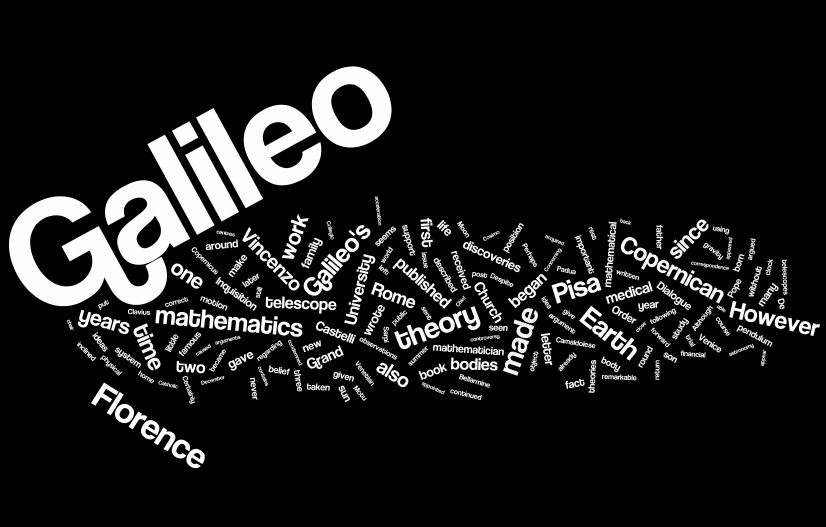
*
“Romania really has lots of nice programs
including poetry and other arts in astronomy.
"astrofolk" music and "Galilean" poetry?
Well,
you have new things there, I think!”
-Mike Simmons (U.S.A.,
Founder and President of Astronomers Without Borders,
advisor of Galilean Nights)-
*
A GATE IN THE HEAVENS
(2009.10.22, morning)
-photo by Valentin Grigore-
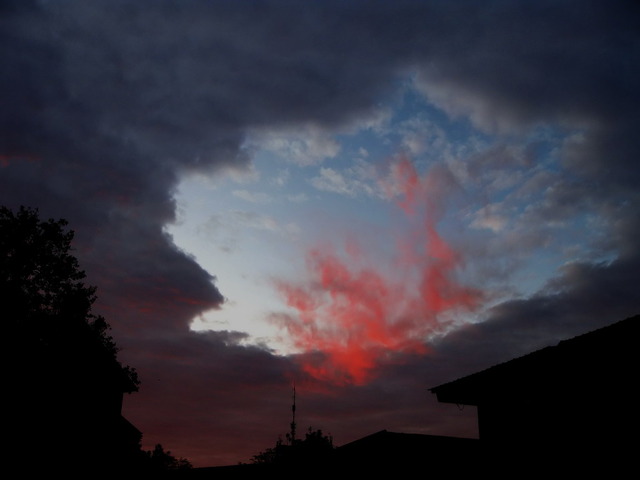
*
The idea of another major project for the sky lovers and the large public,
Galilean Nights,
during the International Year of Astronomy 2009,
came after the extraordinary success of
100 Hours of Astronomy (2009.04.02-05),
the largest astronomical project of all times.
This time, amateur and professional astronomers from all over the world
were called to made presentations, sidewalk astronomy, sky observations,
star count, remote astronomy, and astrophotography,
“pointing their telescopes to the wonders
that Italian astronomer Galileo Galilei observed 400 years ago”
(especially to the planet Jupiter).
*
VISIONS ON GALILEAN OBJECTS
-astropoem in artworks by Calin Niculae-
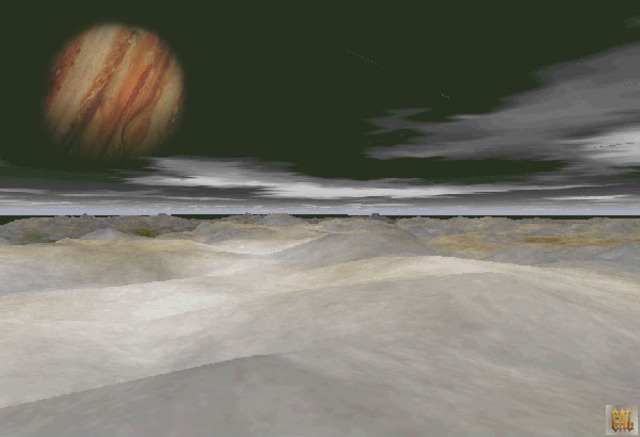
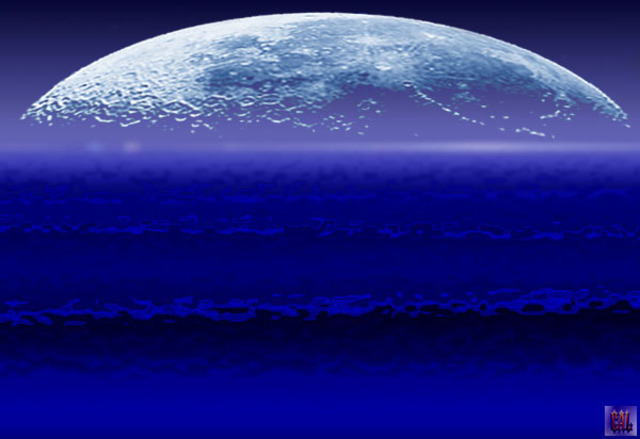
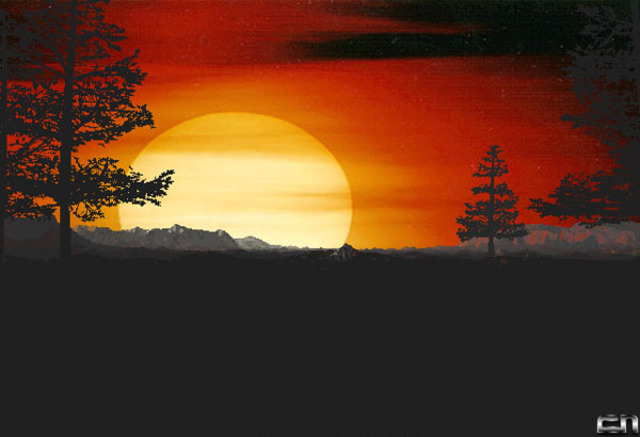
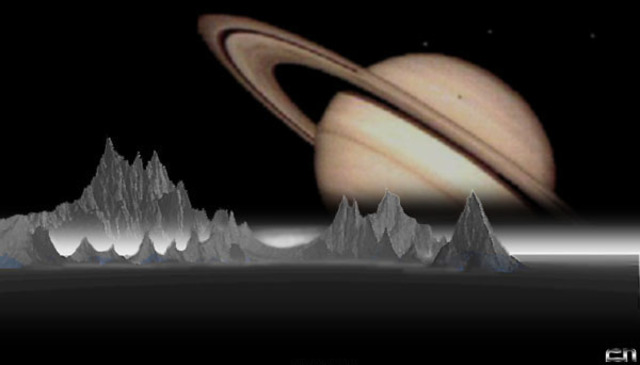
*
One of the 88 countries that participated in Galilean Nights
(a global project powered by
the European Southern Observatory and the European Space Agency)
was Romania.
The largest event in this country was organized by Valentin Grigore
and the Romanian Society for Meteors and Astronomy-SARM
(that also were general coordinators for Romania)
in the town of Targoviste (a former Capital of the Romanian Land).
*
THE BANNER OF THE TARGOVISTE FESTIVAL
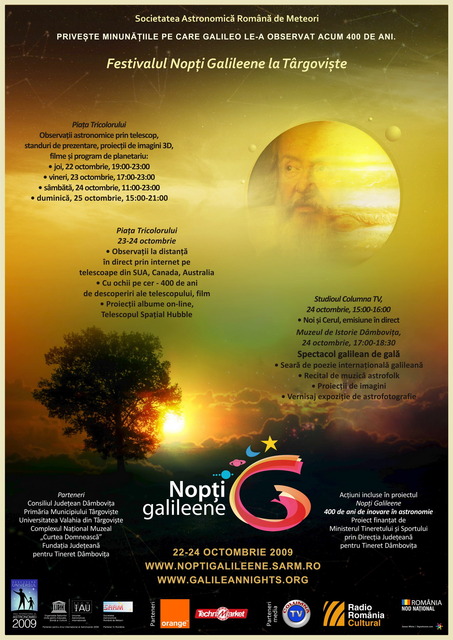
*
The “Galilean Nights / Nopti Galileene” Targoviste festival contained:
-A prologue begun in 2009.10.21:
an Orionid meteor shower observational night
in Priboiu (15 km from Targoviste).
-Interviews for national and local mass-media
(including “Radio Romania Cultural”).
-Activities in the central square (“Tricolorul”) of Targoviste:
tents with astronomical products,
debates, projections of images, movies and planetarium programs,
workshops, astroelectronic music, 3D images, remote observations,
an astroart exhibition made by children,
and especially telescopic observations
of the Sun, Jupiter, the Moon and the Pleiades.
-A special live broadcast
(“Us and the Sky / Noi si Cerul”, Columna TV, Targoviste)
dedicated to this event.
-The Galilean Gala Astroshow at the Dambovita History Museum, composed of:
an astrophotography exhibition, astromovies,
the International Galilean Poetry Evening and an astrofolk music recital
(in fact, that show also represented a gala of
SARM’s yearly Cosmopoetry Festival, founded in 1996).
*
ORIONID NIGHT
(2009.10.21-22)
-photos by Valentin Grigore-
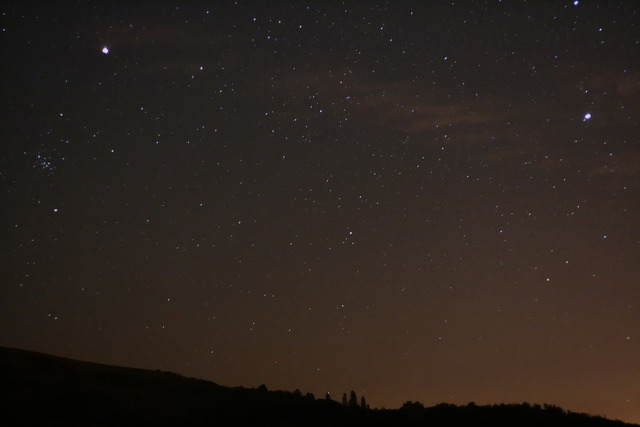
M44, Mars and Procyon
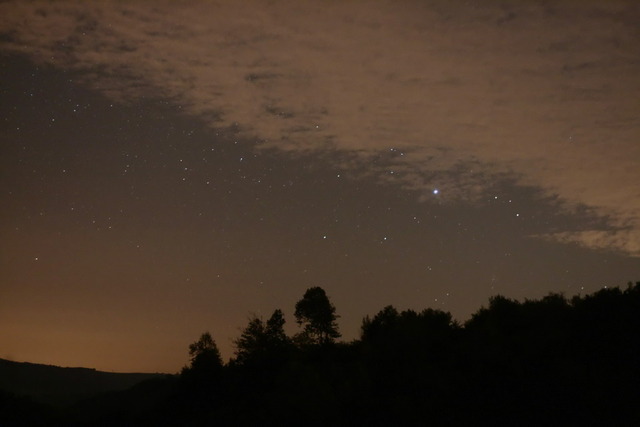
Sirius
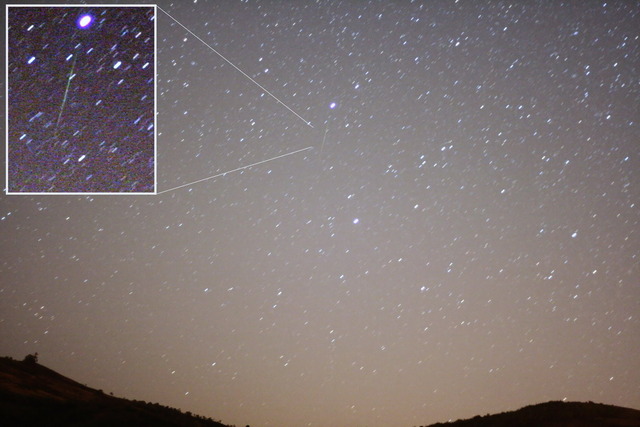
A Sporadic Green Meteor
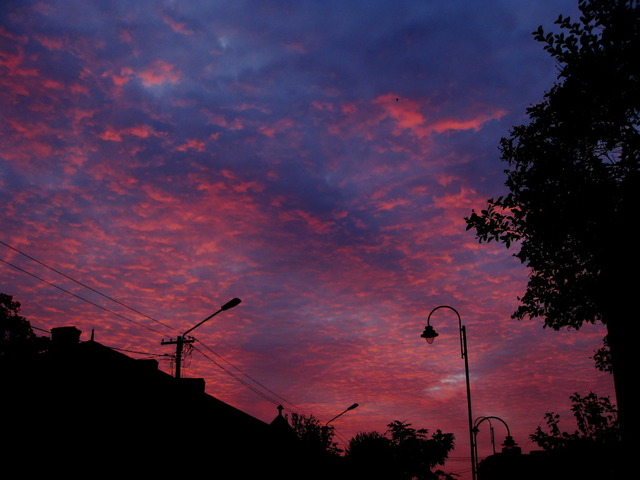
Sunrise
*
The Galilean Gala Show also had a prologue during
the “Us and the Sky / Noi si Cerul” broadcast, Columna TV, Targoviste,
Dambovita County, October 24th, 15:00-16:30.
Thus, the five participants,
Valentin Grigore (coordinator), Andrei Dorian Gheorghe, Dan Mitrut,
Pompiliu Alexandru and Adrian Sima
told about Galileo Galilei, the Galiean Nights global project
and the Targoviste festival,
and finally transformed themselves into a SARM astropoetry dream team,
talked about astronomy in poetry and astronomical humanism,
and gave a short show of astropoetry and astrofolk music.
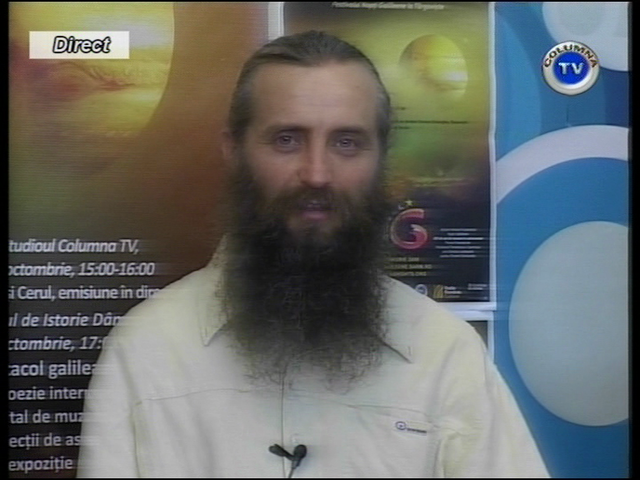
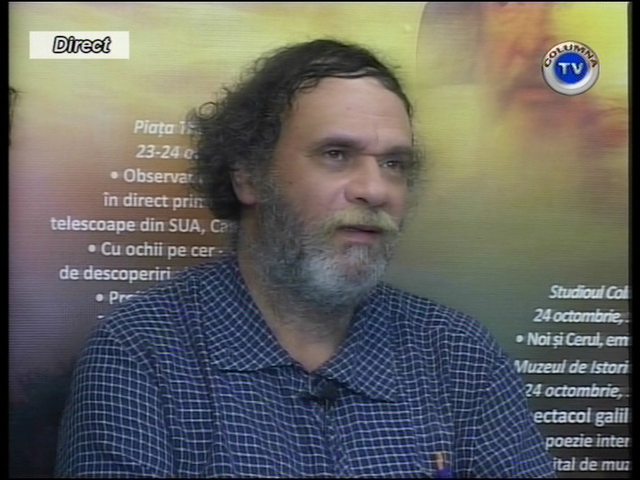
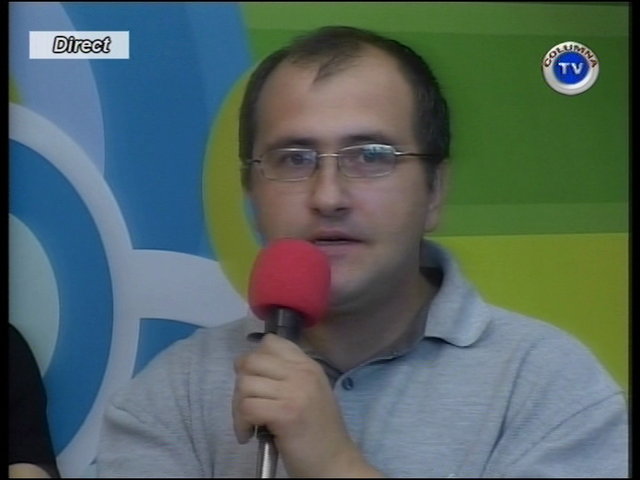
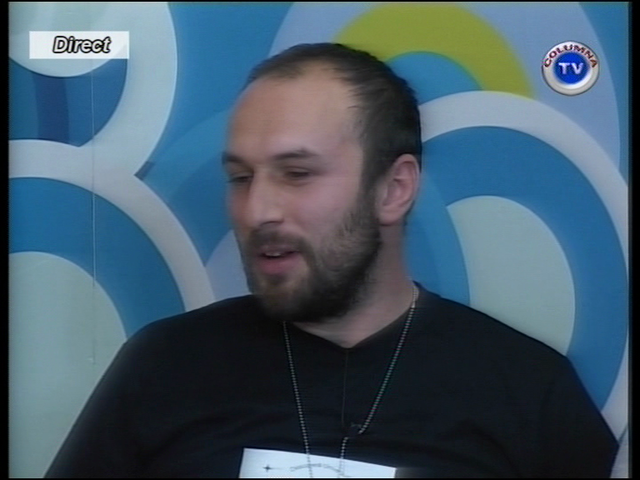
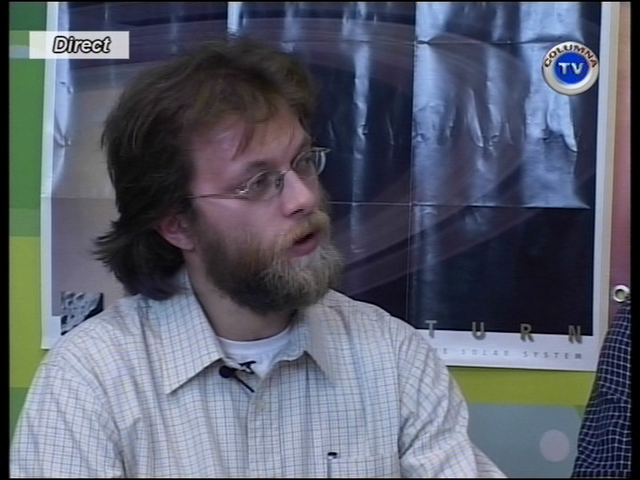
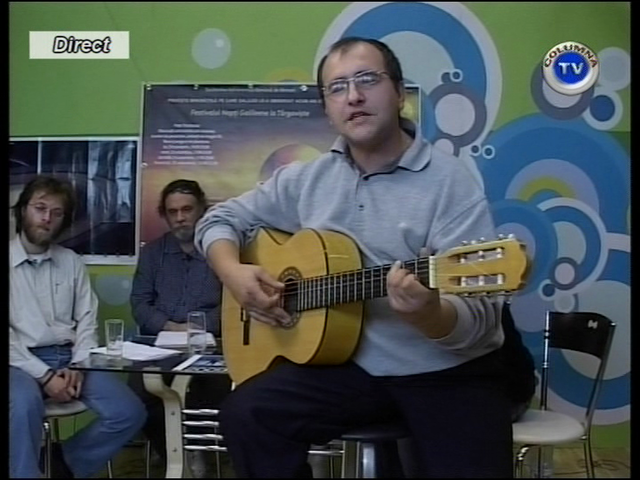
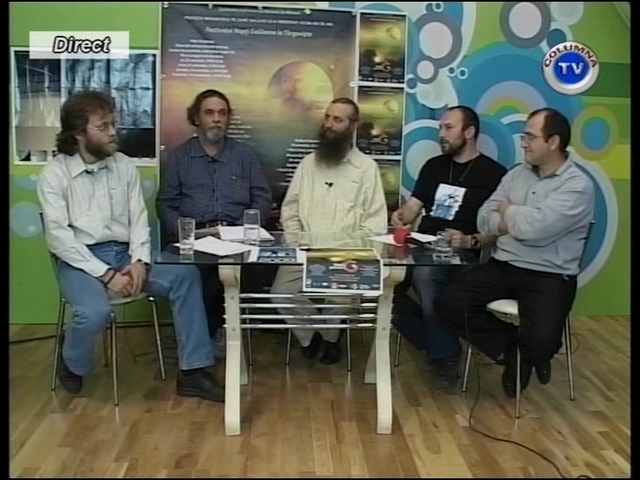
“Galileo Galilei”(performed by Andrei Dorian Gheorghe
with the vestmental help of the “Mihai Popescu” Theatre from Targoviste)
did not miss those moments…
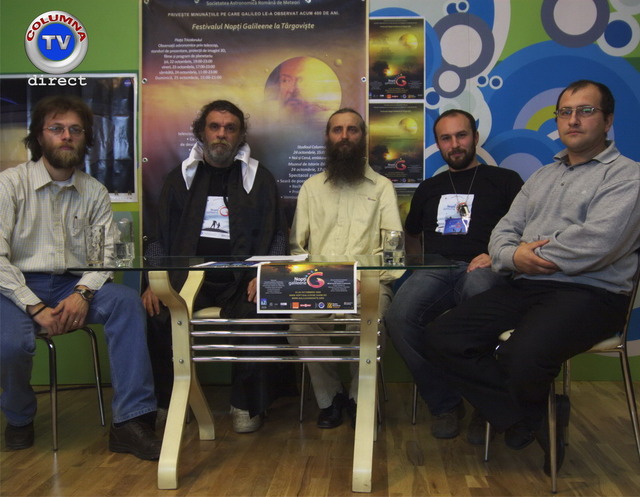
*
Afterwards the SARM astropoetry dream team,
plus Ciprian Grigorescu (astrophotography exhibition coordinator),
went to the History Museum of Dambovita County.
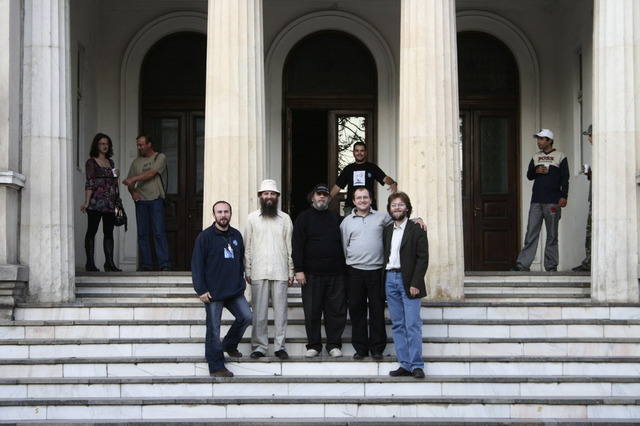
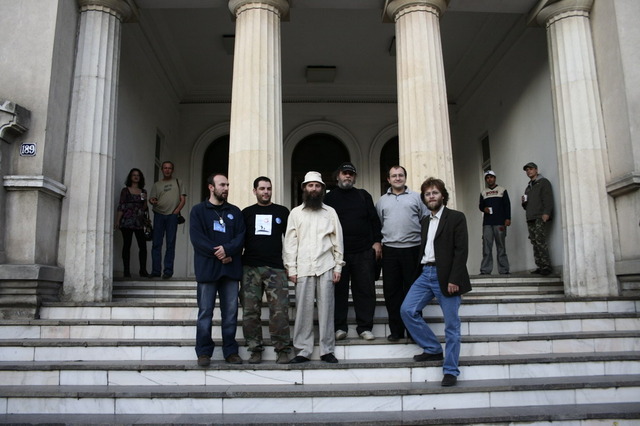
*
The Galilean Gala Show began with the opening
of the SARM astrophotography exhibition,
based on images taken during the expeditions of 2009
and which adorned the walls of the hall,
and continued with a few movies of the International Year of Astronomy.
Then Valentin Grigore
(founder and president of SARM)
told about Galileo Galilei and Galilean Nights,
and presented his own astrophotography movie.
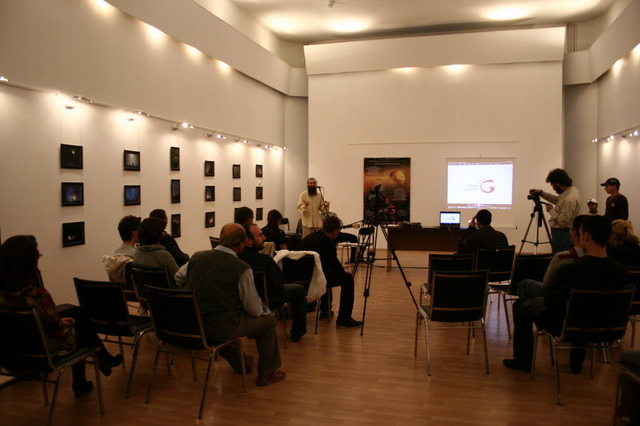
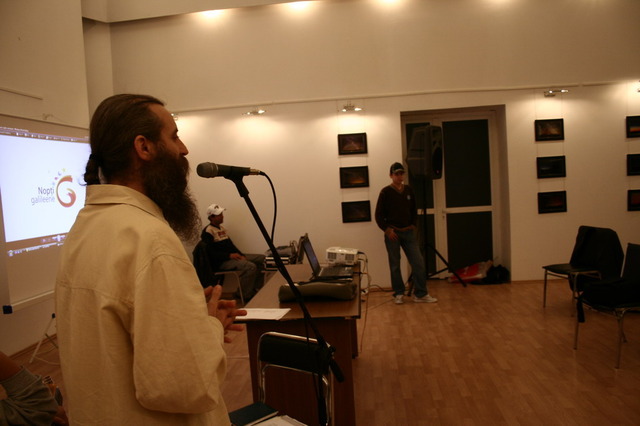
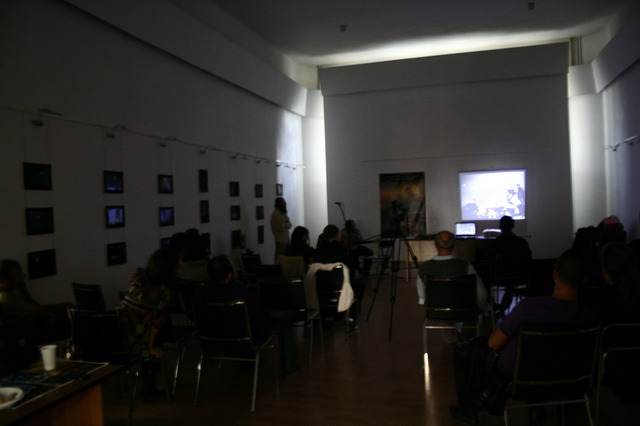
*
Andrei Dorian Gheorghe
(founder and director of SARM’s Cosmopoetry Festival)
made the introduction
to the International Galilean Poetry Evening,
addressed a few thanks
and read his own poem.
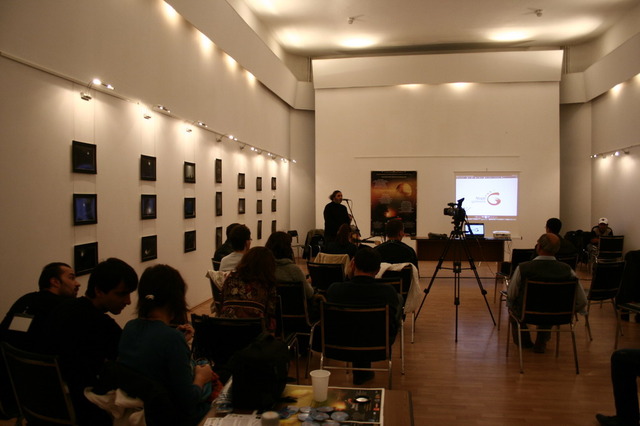
“I thank my parents
Costica Gheorghe (1927.05.24-2007.11.26)
and Steliana (Stella) Gheorghe (1934.05.18-2009.10.01),
who have always given me power, energy and equilibrium
to climb new astropoetic stairs.
I thank Valentin Grigore and his team
for organizing the Galilean Nights local festival in the town of Targoviste.
I also thank all those who have contributed
to this original astropoetry event in the Targoviste festival
and implicitly to this unique web page
for their solidarity around the recent death of my mother,
who had inspired me three months ago
to initiate this astropoetical commemoration
of the Great Astronomer.
And many thanks to my aunt “Tanti Sila” (Vasilica Tudor),
who has helped me to continue the project
“Astropoetry to the International Year of Astronomy”
during the hardest time of my life.”
-Andrei Dorian Gheorghe-
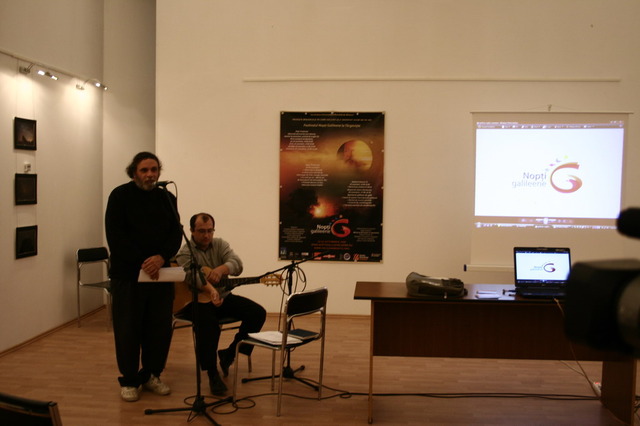
GALILEO
-by Andrei Dorian Gheorghe-
Finally Galileo
became blind for the earthly world
in order to be more concentrated
on the celestial world.
Thus, he could
color the lunar mountains,
caress the planets,
spoil the satellites of Jupiter,
admonish the sunspots,
and play with the heavenly bodies
from beyond the sky
of the fixed stars.
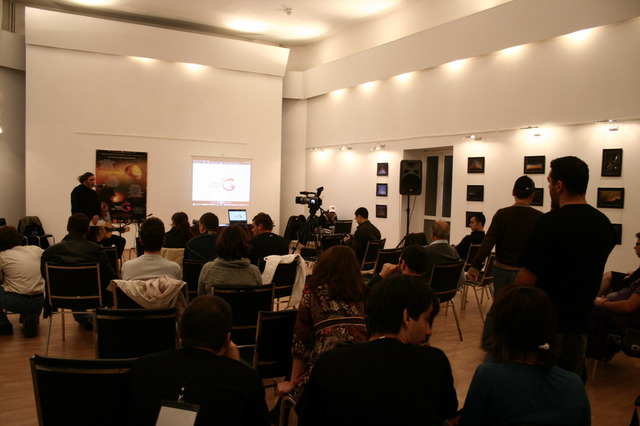
*
Dan Mitrut
(founder of Romanian astrofolk music in 1997)
sang seven of his songs on astronomical themes
in alternation with the moments of poetry.
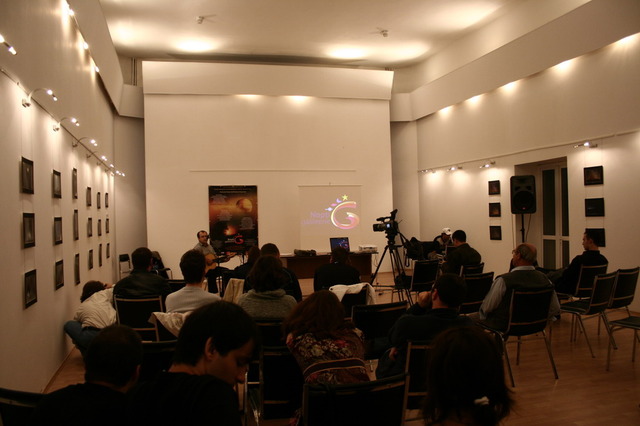
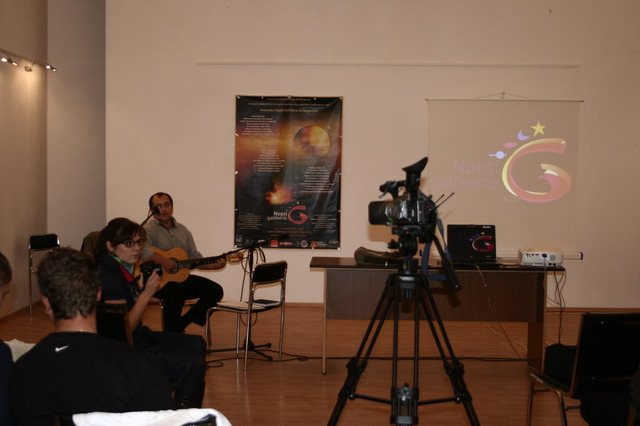

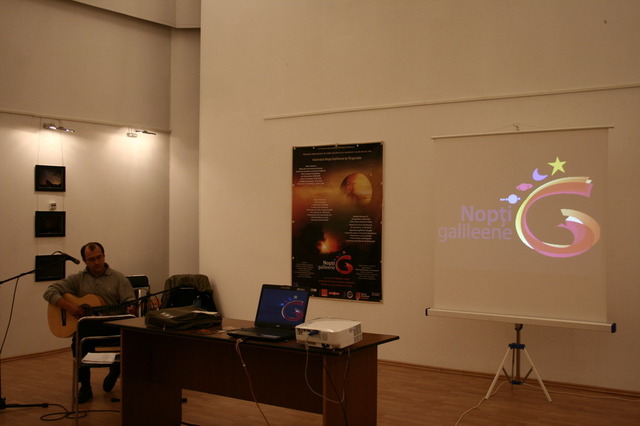
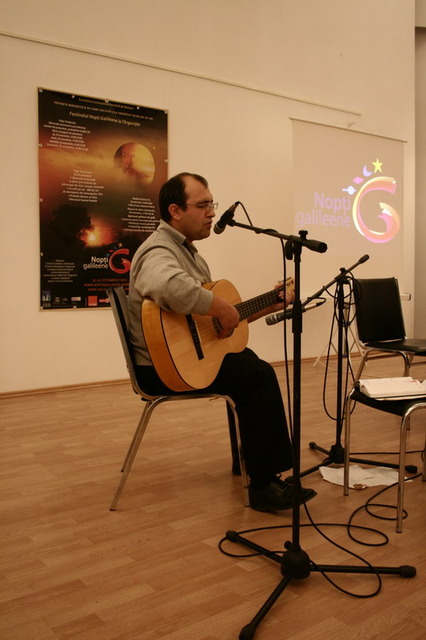
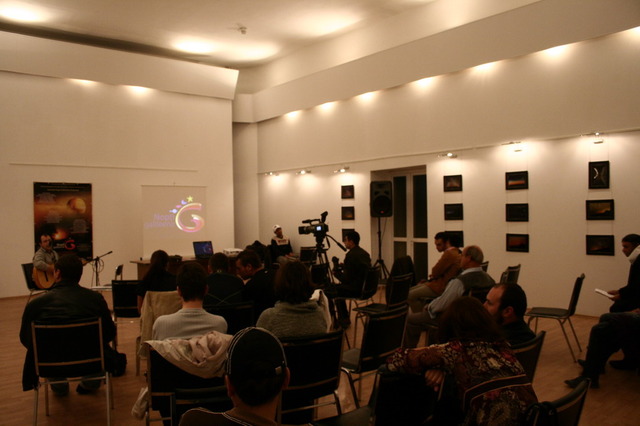
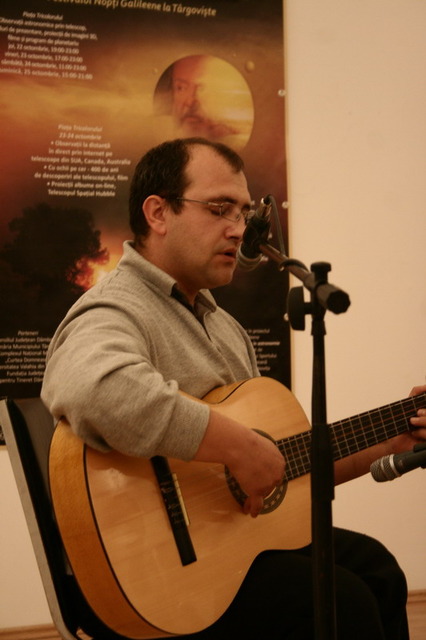
*
Even “Galileo Galilei”, our contemporary,
came to read, in alternation with Dan Mitrut’s songs,
the grateful letters received from four continents
as astropoetic writings
(with the mention that some of his admirers
came personally here to read their poems finally):
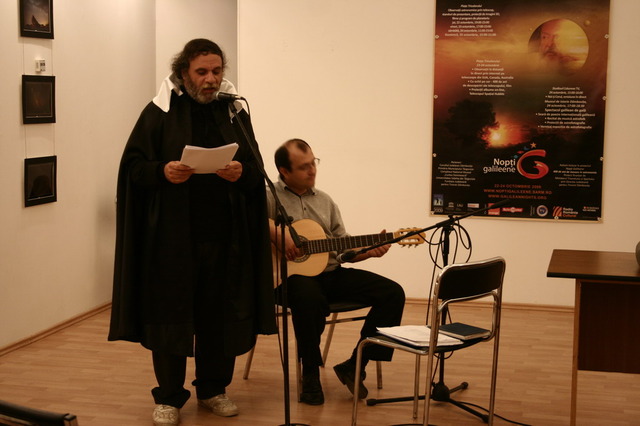
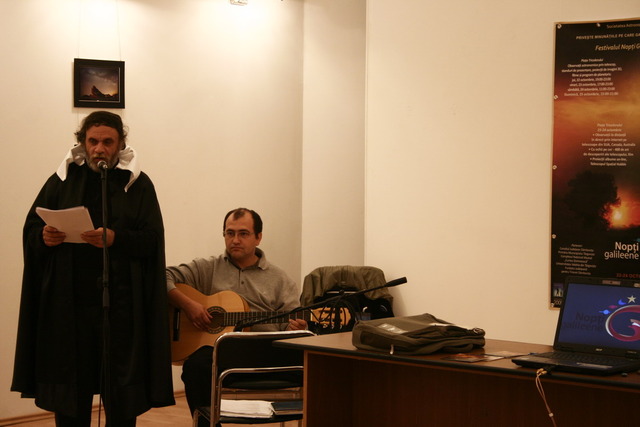

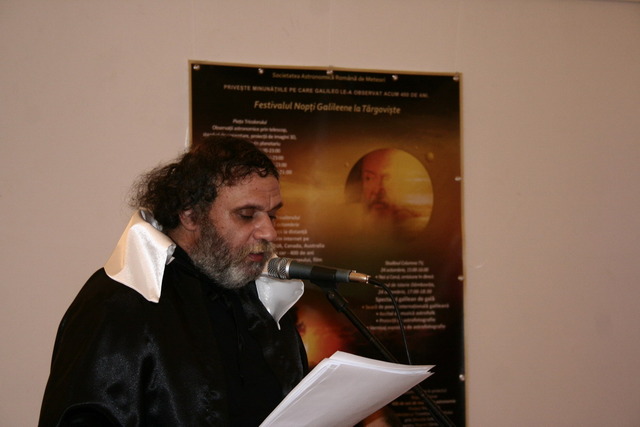
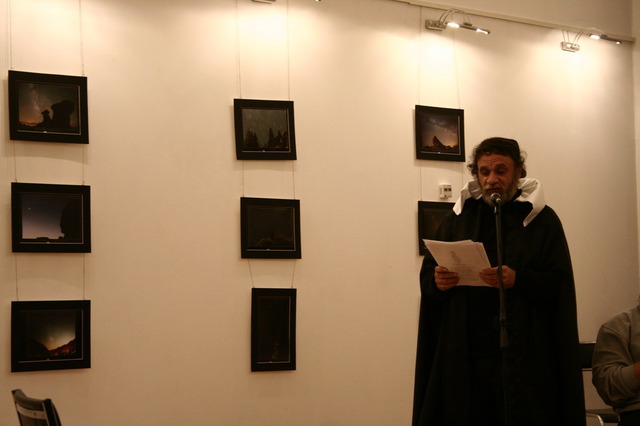
*
HAIKU
-by Iulian Olaru-
Watching the skies
Galileo Galilei
new light
*
GALILEO GALILEI
-by David Asher (U.K.,
astronomer at Armagh Observatory, Northern Ireland,
counsellor of the International Meteor Organization
and discoverer of asteroids)-
The Tower of Pisa's so tall
That Galileo dropped ball after ball
From the top to the ground -
He watched them and found
That the time was the same for them all.
*
GALILEO'S VINDICATION
-by Bruce Boston (U.S.A.,
the first Grand Master of SF poetry)-
recanting the truth
meant nothing to the future
the stars do not lie
*
AT CASTELLO GANDOLFO
-by Steve Sneyd (U.K.,
Director of Hilltop Press
and Editor of Data Dump)-
Boasts owns telescope
Galileo himself made
with own hands. Said loud -
only privatest whisper
admits true Earth moves with it.
*
THE OLD MAN AND THE PYRE
-by Gelu-Claudiu Radu-
The state against him.
Galileo Galilei.
“E pur si muove”.
*
OTHER SEQUENCES FROM THE DAMBOVITA HISTORY MUSEUM
DURING THE GALILEAN GALA SHOW
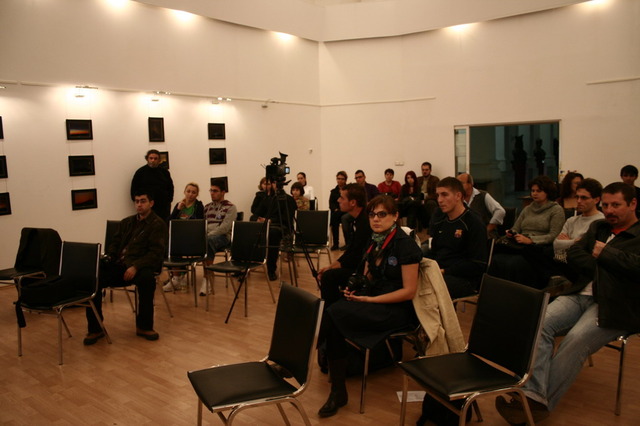
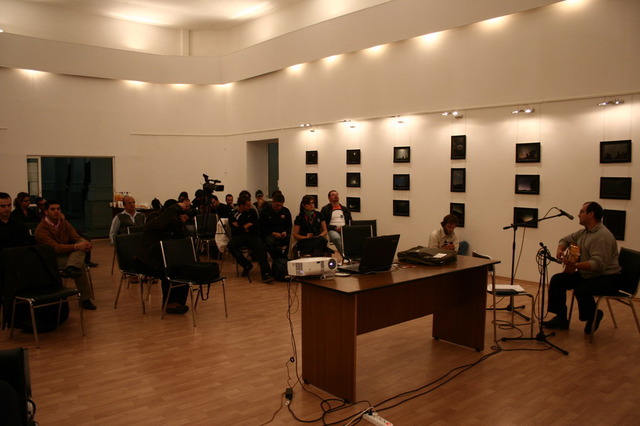

*
THE GREAT GALILEO SPIN
-by Gerald England (U.K.,
Editor of New Hope International
and Honorary Member of the International Artists and Writers Academy)-
Pisa born man
whose father carries out experiments on strings
to support his musical theories.
Off you go to the Camaldolese Monastery
on the magnificent forested hillside
at Vallombrosa.
They want you to be a medicine man
but the mathematics of Euclid and Archimedes
mesmerise you more.
In "La Balancitta" you describe Archimedes' method
of finding the specific gravities of substances
using a balance.
You correspond with Clavius and Guidobaldo del Monte
concerning the theorems you have proved
on the centres of gravity of solids.
You lecture on the dimensions and location of hell
in Dante's Inferno
at the Academy in Florence.
The idea comes that one can test
theories about falling bodies
using an inclined plane
to slow down
the rate of
descent.
At the university of Padua
you teach Euclid's geometry
and geocentric astronomy
to medical students.
In three public lectures
you argue against Aristotle,
use parallax arguments to prove
that the New Star
can not be close to the Earth
and come out as a Copernican.
You grind and polish lenses
until you have an instrument
with a magnification of around eight or nine.
You demonstrate to the Venetian Senate
the commercial and military applications
of the telescope you call a perspicillum
for ships at sea
and sell the sole rights
for manufacture to the Senate.
In the book "Starry Messenger"
you claim to have seen
mountains on the Moon,
four small bodies orbiting Jupiter
and proved the Milky Way
is made up of tiny stars.
In a letter to the Grand Duchess
you vigorously attack the followers of Aristotle,
arguing strongly
for a non-literal interpretation
of Holy Scripture
when that would contradict
facts about the physical world
proved by mathematical science.
You quite clearly state
that the Copernican theory
is not just a mathematical calculating tool,
but a physical reality.
You hold that the Sun is located
at the centre of the revolutions
of the heavenly orbs
and does not change place,
and that the Earth rotates on itself
and moves around it.
You confirm this view
not only by refuting Ptolemy's and Aristotle's arguments,
but also by producing many for the other side,
especially some pertaining to physical effects
whose causes perhaps cannot be determined
in any other way,
and other astronomical discoveries
that clearly confute the Ptolemaic system
but agree admirably with this other position.
Found guilty of heresy
and condemned to lifelong imprisonment,
the sentence amounts to house arrest,
living first with the Archbishop of Siena,
then later returning home to Arcetri
though spending the rest of your life watched over
by officers from the Inquisition.
Your "Discourses"
are smuggled out of Italy,
and taken to Leyden in Holland
and published.
There you develop
ideas of the inclined plane
assuming that the speed acquired
by the same movable object
over different inclinations of the plane are equal
whenever the heights of those planes are equal.
You describe an experiment using a pendulum
to verify this property of inclined planes
and give a theorem on acceleration of bodies in free fall
and finally conclude
that the distance that a body moves from rest
under uniform acceleration
is proportional to the square of the time taken.
You die in early 1642,
your body concealed
and only placed in a fine tomb
in the church in 1737
by the civil authorities against
the wishes of many in the Church.
On 31st October 1992,
350 years after your death,
Pope John Paul II gives an address
on behalf of the Catholic Church
in which he admits
that errors had been made
by the theological advisors in your case.
He declares the Galileo case closed,
but he does not admit
they were wrong to convict
on a charge of heresy
because of the belief
that the Earth rotates round the sun.
O Galileo
how do you spin in your grave?
*
GALILEAN NIGHTS - TARGOVISTE:
AROUND THE TELESCOPE IN THE “TRICOLORUL” SQUARE
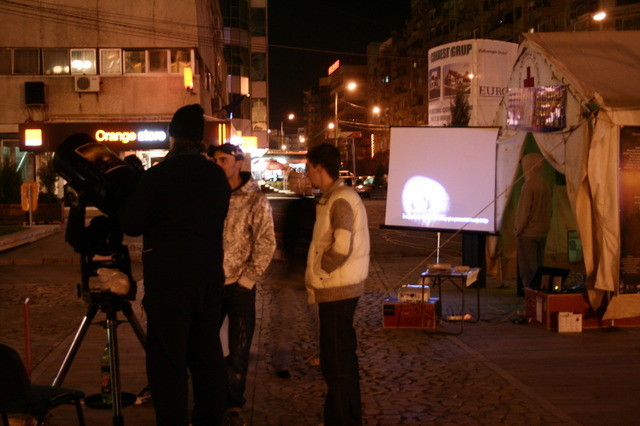
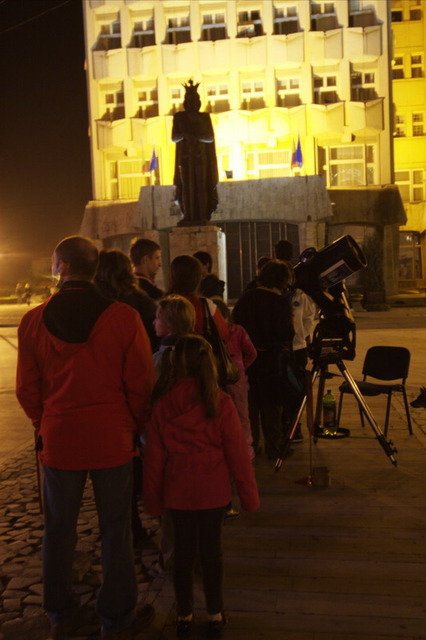

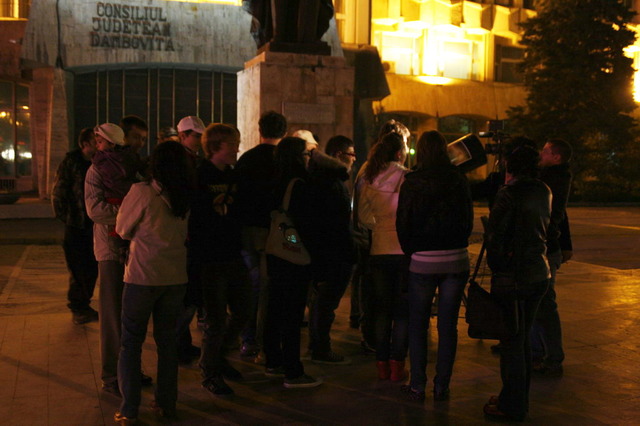
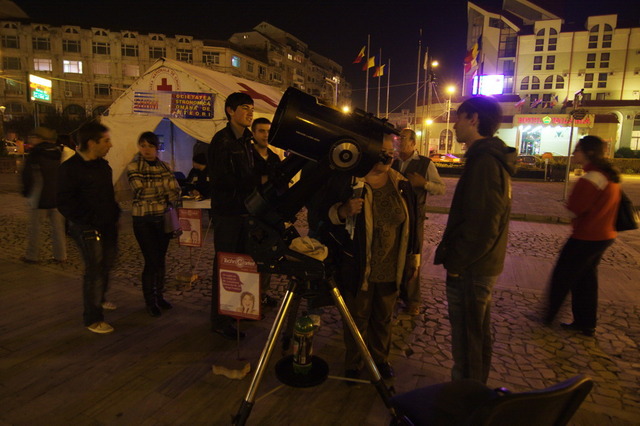



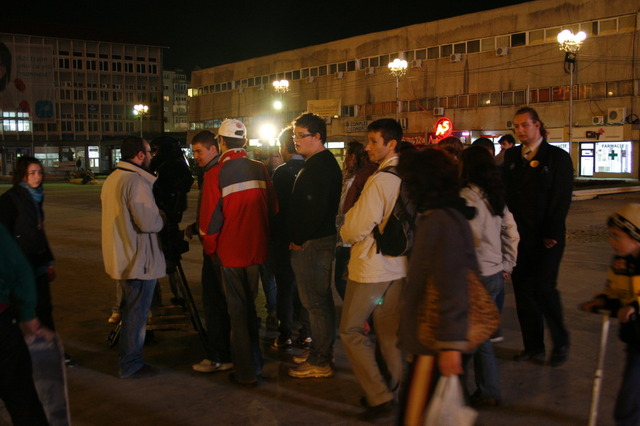
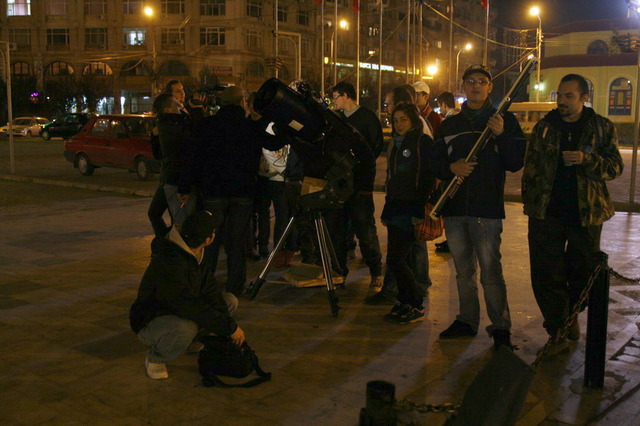
*
EPPUR SI MUOVE
-by Zigmund Tauberg-
He watched the stars by lunette
for the first time,
observed four other elements
moving around Jupiter,
studied the fall down of the bodies,
the oscillations of the pendulum,
and many other things
that enriched enormously science.
But as he provoked much trouble
when said that Terra moves around the Sun,
he was judged,
accused of heresy,
and threatened to be burnt on a pyre.
So he retracted his affirmation,
but leaving his judges
Galileo whispered
“Eppur si muove”
just because the truth is a tower
stronger than any threatening power.
*
A HOLLANDER'S SECRET WEAPON: 1609
-by Marge Simon (U.S.A.,
Editor of Star*Line, the Journal of the Science Fiction Poetry Association)-
Invention of a spyglass
sent Galileo off to ponder
a re-invention unintended
for a combat situation.
A twenty power increase
in the lens, he turned it on the sky,
opening up our galaxy
for harmless speculation.
Four centuries have passed,
radar's replaced the glass,
yet still we war, and still,
we haven't touched the stars.
*
STARRY MESSENGER
-by Diana Maria Ogescu-
If in that heliocentric system:
Jupiter would not have had satellites,
the Sun would have rotated chaotically,
without spots,
and Venus would not have had phases,
then the Starry Messenger
would have missed his appearance.
*
GALILEAN NIGHTS - TARGOVISTE:
PROMOTIONAL MATERIALS
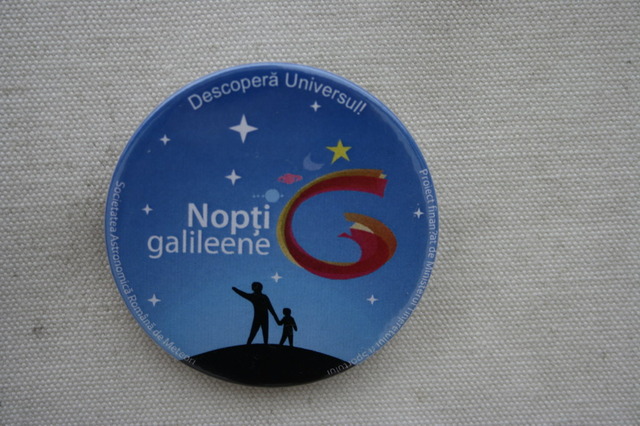
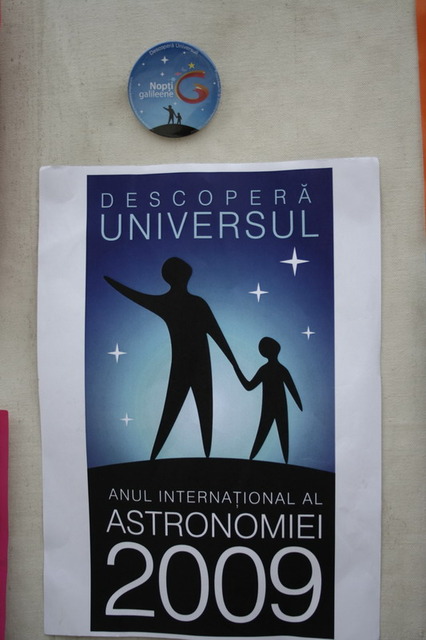
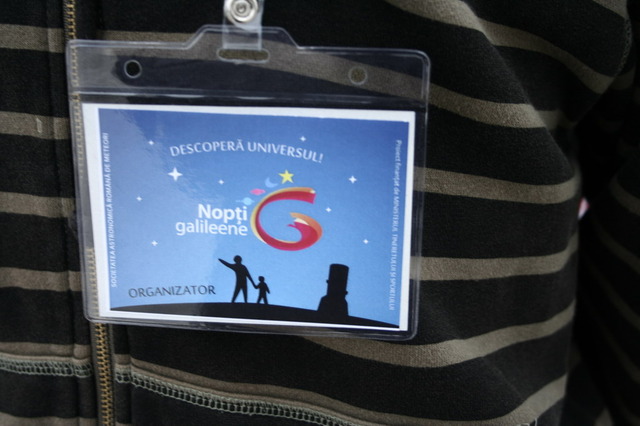
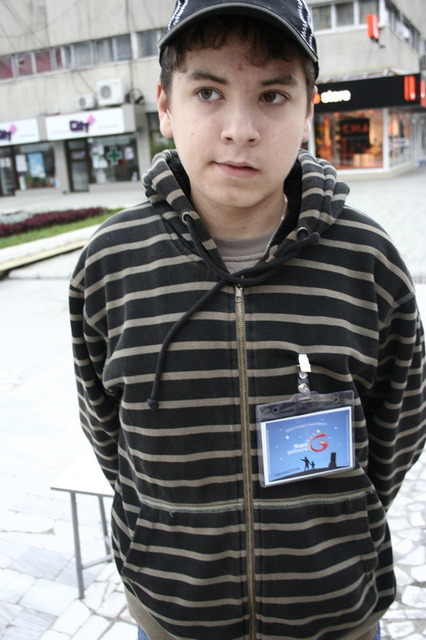
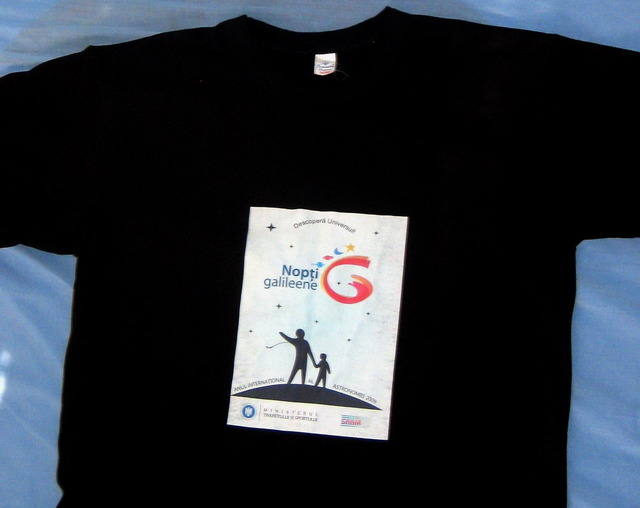
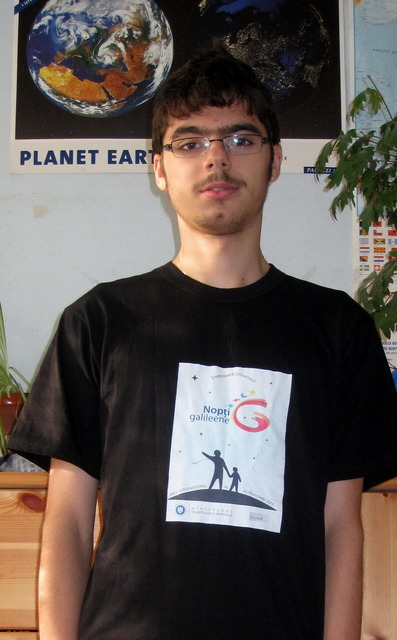
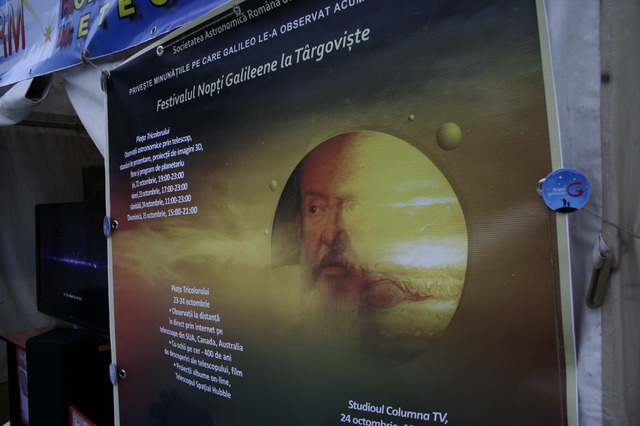
*
BLIND
-by Alfredo Caronia (Italy,
co-discoverer of 3 asteroids)
Blind
in the sign of extreme contrasts,
embarrassed in front
to heaven,
evidence of the celestial mechanics
and of the relations
between celestial bodies,
thrill in the night
of emotional outbursts,
fresh breath of a child,
between the dogmas of the universe,
unconscious
challenge
in front of the shine
of the stars,
until to induce the eye
to look
beyond the limit;
reason
and passion
are
a finishing line
of a leap,
unattainable,
are a finishing line
of a flight,
of quivers
of knowledge,
pushed
for imagining,
and proving
the cosmic design,
to a supreme comparison
with the equilibrium
of the sky;
aim to be achieved
without hesitation
unto to
injure
eyes;
Galileo, blind in the limited time
but, in infinity space, brilliant,
is a furrow in the sky.
*
GALILEAN NIGHTS - TARGOVISTE:
FLASH INTERVIEWS NEAR THE TELESCOPE
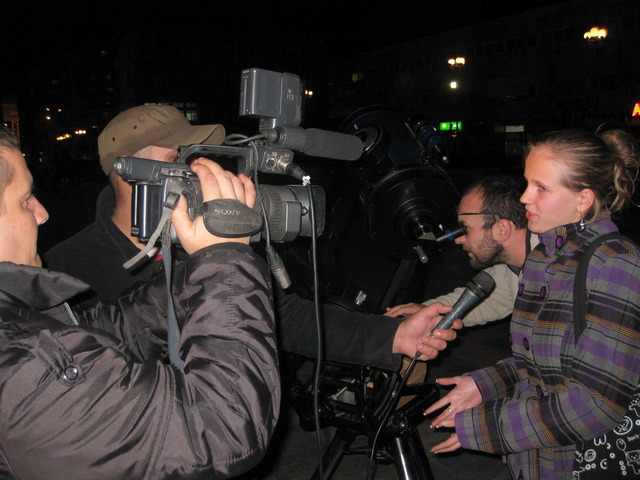
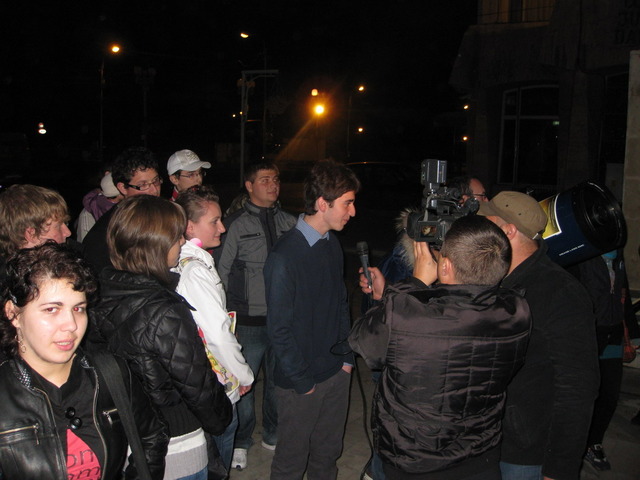
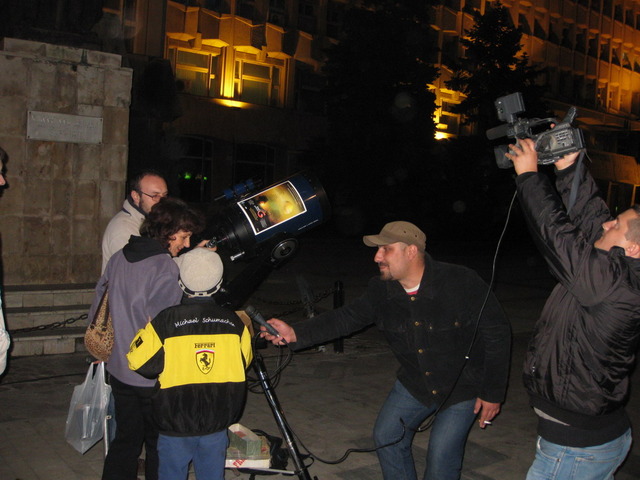
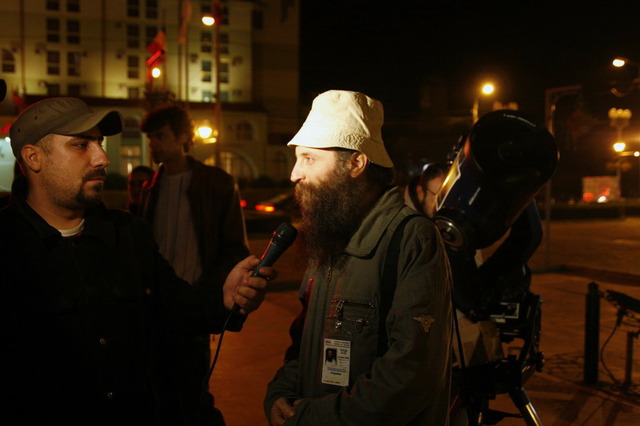
*
GALILEO GALILEI
-by Boris Marian (Mehr)-
I hear your rumble passing through
four centuries,
“Eppur si muove”,
but how many people listen to it?
Stupidity does not feel motion,
folly is sure of its own immortality,
and in the stellar centre
(which does not exist)
a sad and obscure appearance:
mediocrity.
So I have to quote you again:
“Eppur si muove.”
*
GALILEO
-by Arlene Carol (Turkey, south of Troy;
born in U.S.A.)
Of such humble birth,
one could not guess the gift
he would bestow.
Beyond all imagining,
to see
beyond the eye.
*
THE JUDGEMENT OF GALILEI
-by Dominic Diamant-
“You are convicted, cursed heretic:
the saints do not endure you
because you have made a monument
of blamable passion.
We resolutely reject
your stupid, turbulent and defiant idea:
Terra cannot move
around the Sun!”
But Galileo whispered
something mysterious,
and “Eppur si muove”, like a bomb,
became, over time, famous.
*
GALILEAN NIGHTS - TARGOVISTE:
PRESS CONFERENCE AT SARM’S HEADQUARTERS
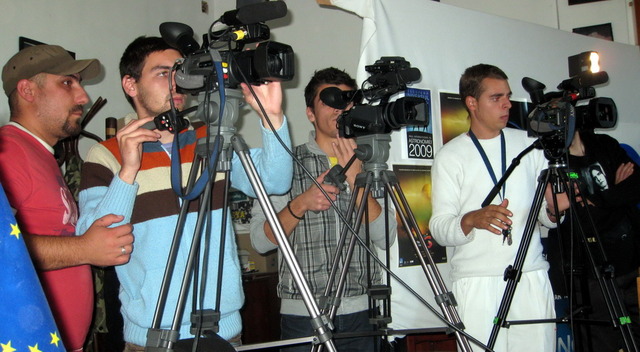
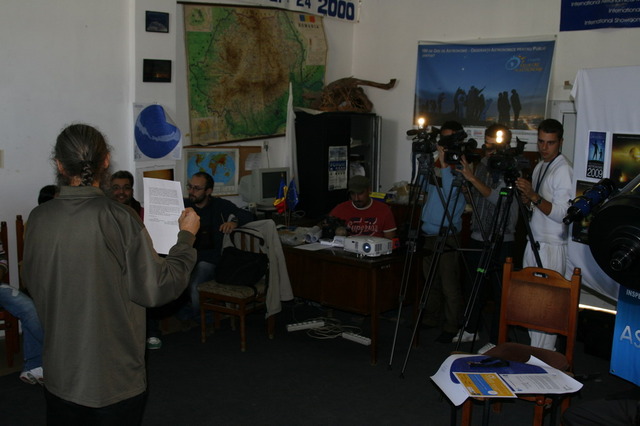
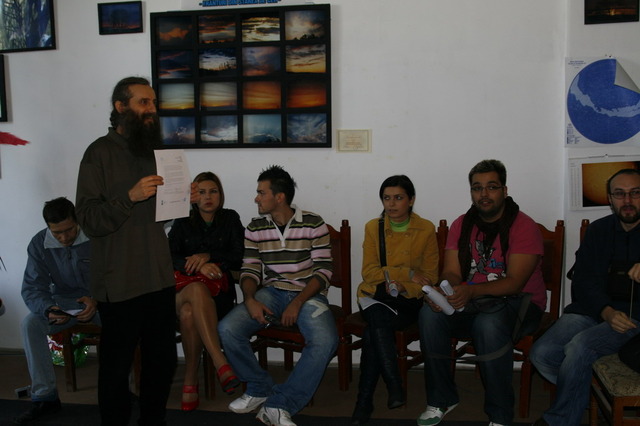
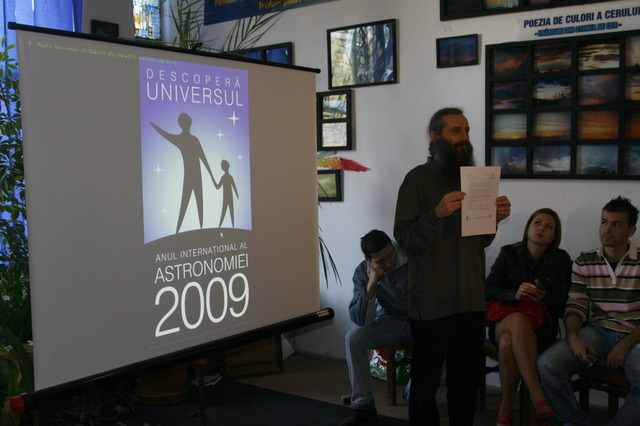
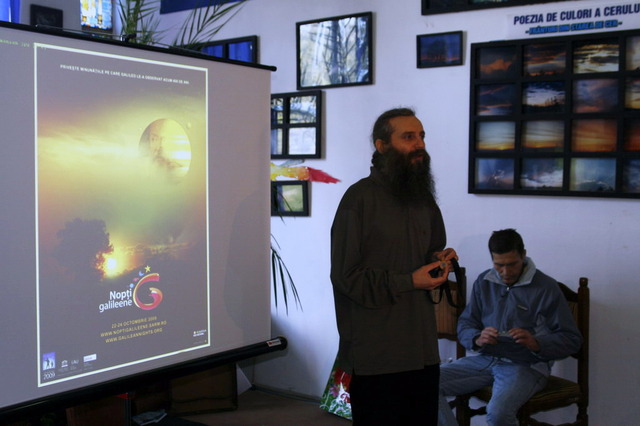
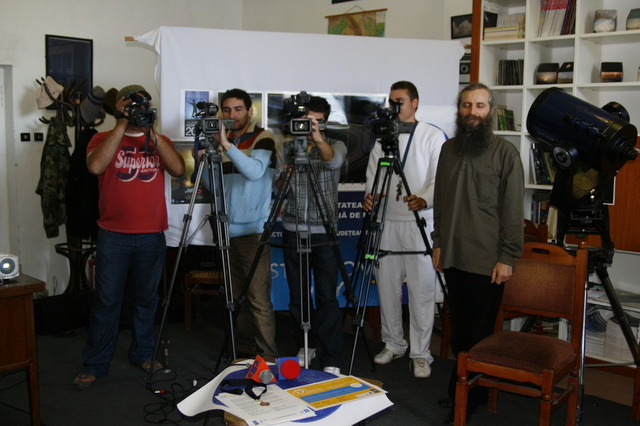
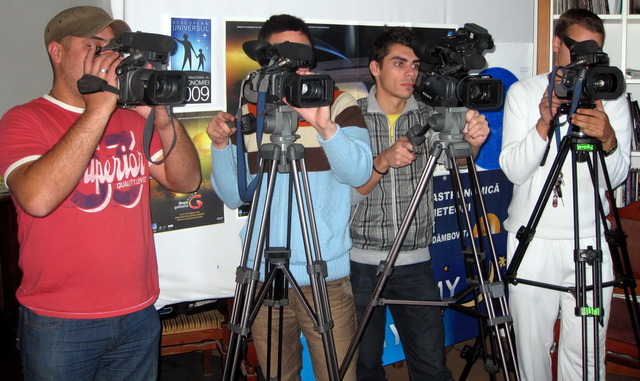
*
GALILEAN THOUGHTS
-by Alastair McBeath (U.K.,
Vice-President of the International Meteor Organization)-
Despite having died in 1642,
Galileo Galilei is a difficult person to avoid,
especially for anyone involved with astronomy,
whatever their level of interest or expertise.
My earliest childhood recollection of him doesn't conjure up a man,
but a place-name, Pisa in Italy, from whose Leaning Tower
it was said he had dropped two objects of different weights,
to prove that gravity acts equally on all objects, irrespective of their mass.
The story may not be true, but Apollo 15's mission commander Dave Scott
on August 2nd, 1971 near Hadley Rille, repeated the experiment on the Moon,
using a falcon's feather (because that lunar module was called "Falcon")
and a geological hammer.
Seeing the experiment on the Moon on TV is what I actually recall,
but the connection was made.
Within a couple of years, Galileo impinged on me again,
when I first looked at Jupiter through good binoculars
and saw the faint "stars" alongside the middle of the planet's tiny disc,
the Galilean Satellites.
It was only sometime later I realised this was the same Galileo,
and discovered why those four Jovian moons were so-named.
That was 400 years ago next year.
I still enjoy seeing those miniature worlds
performing their gravitationally-regulated dance about Jupiter.
And this year, IYA2009, we celebrate Galileo's scientific achievements,
including his first recorded telescopic observations of the Moon,
a place where a mere 360 years later, men would first walk,
helping us still to remember Galileo,
and enthuse fresh generations of scientists to follow him.
*
GALILEAN NIGHTS - TARGOVISTE:
“SHE IS A (LITTLE) ASTRONOMER”
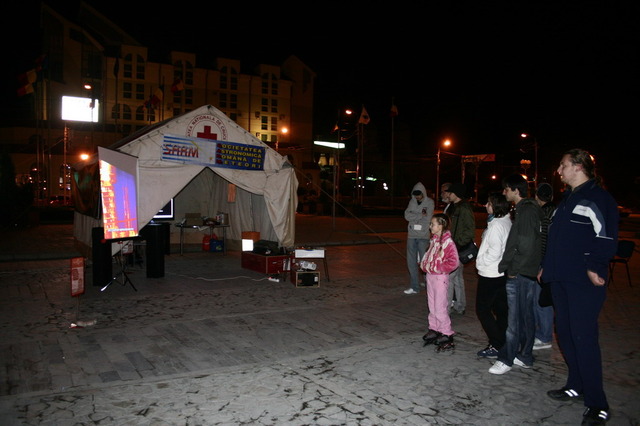
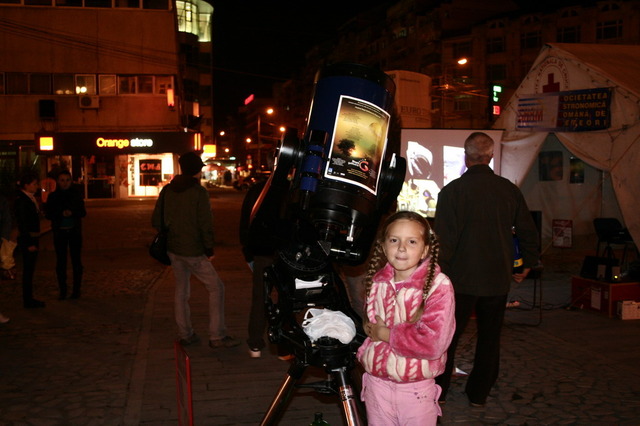
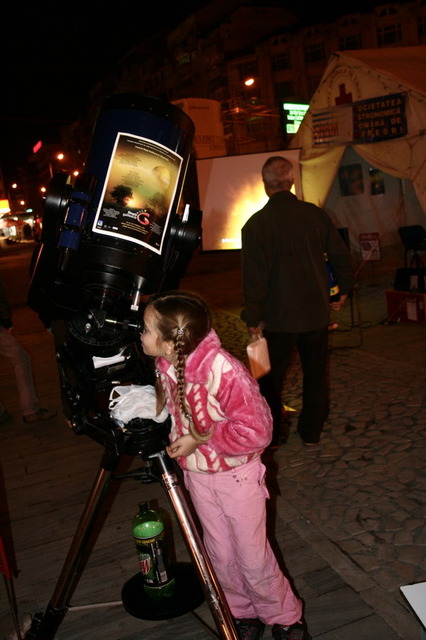
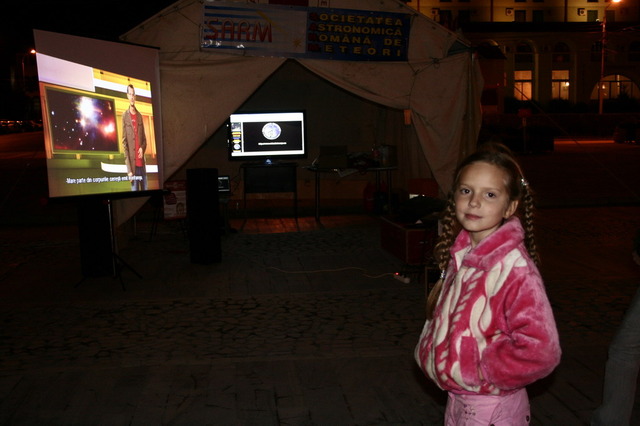
*
GALILEO AND THE MOON
(variant 2009)
-by Florian Saioc-
You always provoke me,
crazy Moon.
You dance in the sky
like a girl
but are too old
to run after the Sun.
Your beams are pale,
don’t you see?
Why should I come
to your sky?
What can your borrowed light
tell me?
The better you and the starry sky
come to my soul.
Soon,
crazy Moon.
*
IT DOES MOVE
-by Danut Ionescu (New Zealand,
Auckland Astronomical Society;
born in Romania)-
Something does move,
said Hipparchus,
discovering the precession of the equinoxes.
And yet it does move,
affirmed Galileo Galilei,
leaving the Tribunal of the Inquisition.
It does move,
said Einstein too,
completing:
But it is so important
whence you watch the movement!
*
GALILEO GALILEI
-by Irina Cristescu-
Revolving our destinies
into circles hidden from the ignorant eyes,
in a historical moment
the speed of light and the speed of time merge,
and a new star, of blue knowledge,
rises from the galaxy,
from the Galilean world,
a new theory among mysterious faces,
a superior understanding between
the human destinies and the astral destinies,
that the key of life exists in the light,
beyond time…
*
GALILEAN NIGHTS - TARGOVISTE:
DURING THE DAYTIME IN THE “TRICOLORUL” SQUARE
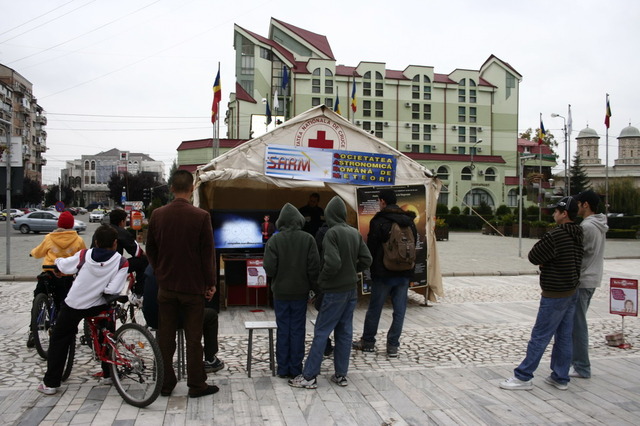
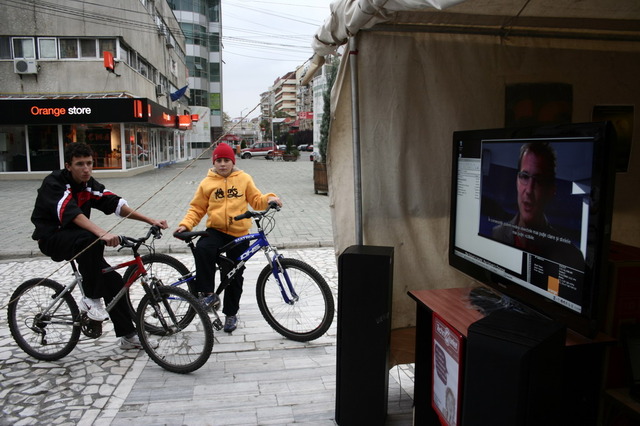
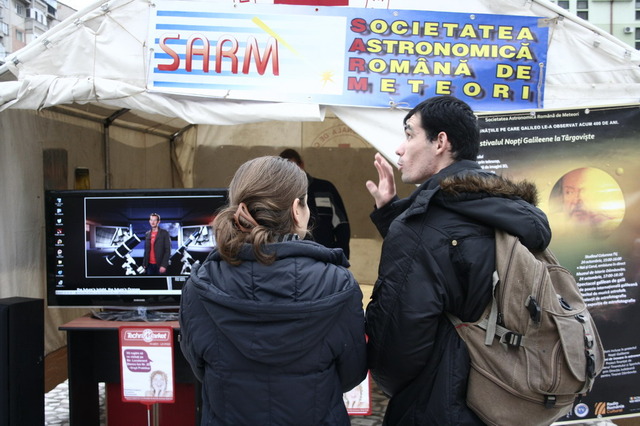
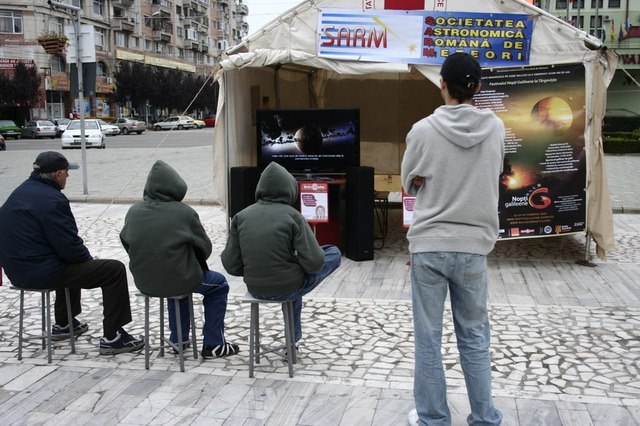
*
“YET IT DOES MOVE”
-by John Francis Haines (U.K.,
Leader of the Eight Hand Gang - British network of SF poets)-
Eight years’ house arrest (until he died)
Just for saying the Earth went round the Sun –
Yet another of those dangerous ideas
Which seem to pop up every now and then
That those in charge don’t appear to care for much.
Still, the pardon he was finally granted
In 1992 must have given
Great comfort, plus the thrill of being proved right.
*
EPPUR SI MUOVE
-by Silviu Georgescu-
Four centuries ago
we were timidly watching the sky,
the stars’ twinkles were still mysteries,
we were floating in the darkness of a false science,
but a MAN’s mind created the IDEA.
The stars found a contour, a basis, a sense,
through the wonderful “eye” made by Galilei,
the titan opened a fascinating world,
a moving world,
even the forbidden fruit.
Although he was threatened
with the burning on a pyre,
Galileo whispered “Eppur si muove”,
those immortal words,
and today we say like him
and feel a great thrill
when we go to the high target,
led by our will.
*
GALILEAN NIGHTS - TARGOVISTE:
A FEW EXTRACTS FROM MASS-MEDIA MATERIALS
Dambovita TV (capture)
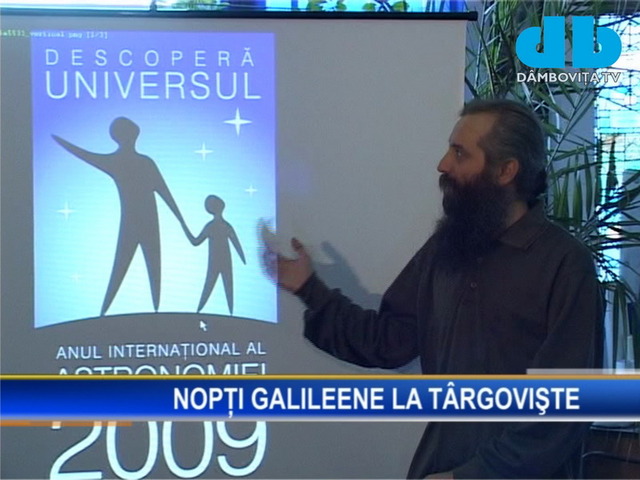
TTV (capture)
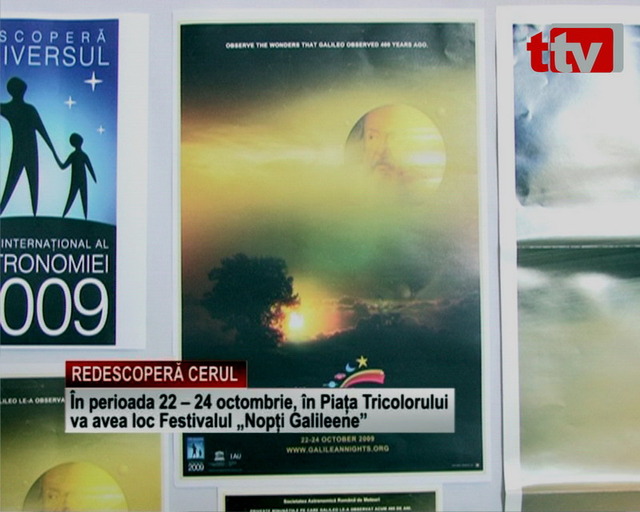
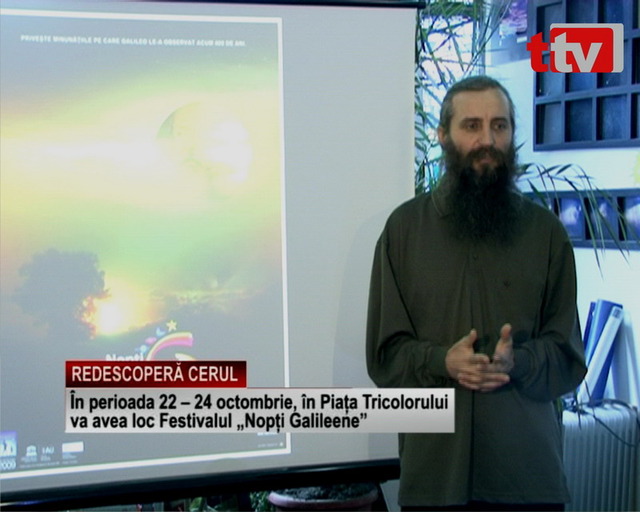
Adevarul de Seara (on-line and printed)
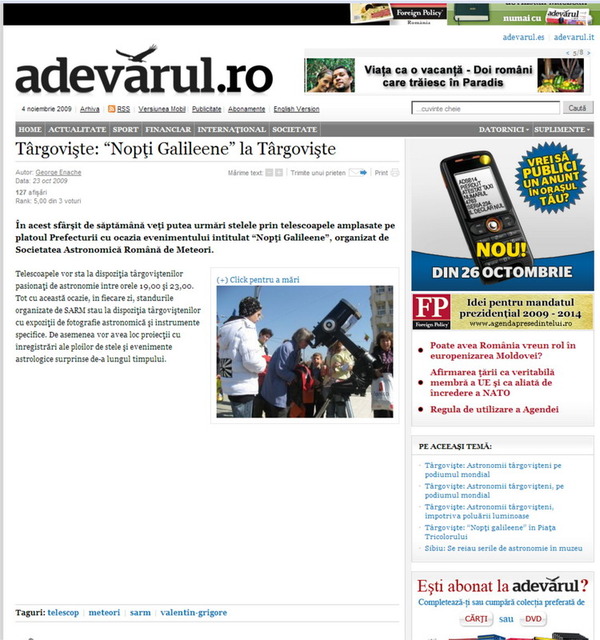
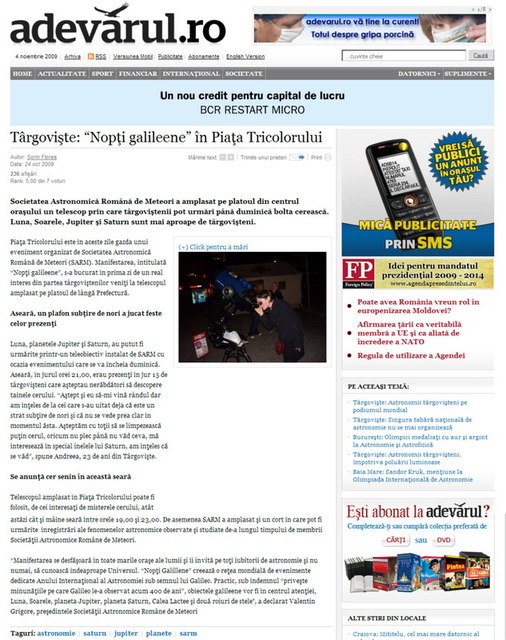
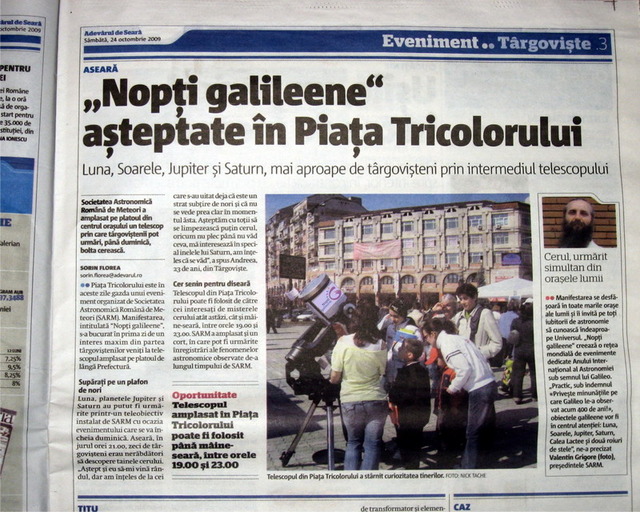
Columna TV (capture)
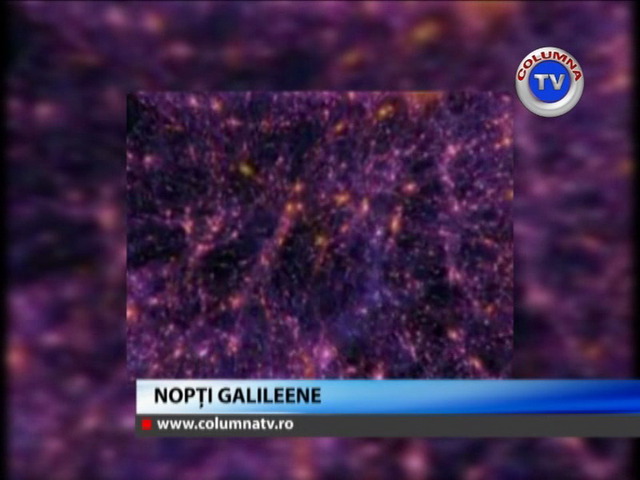
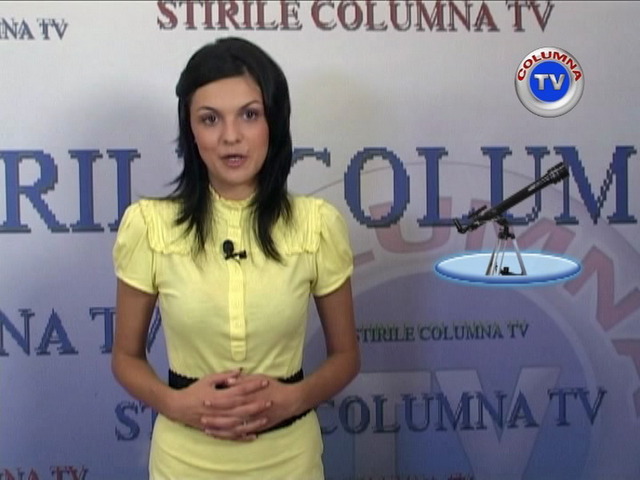
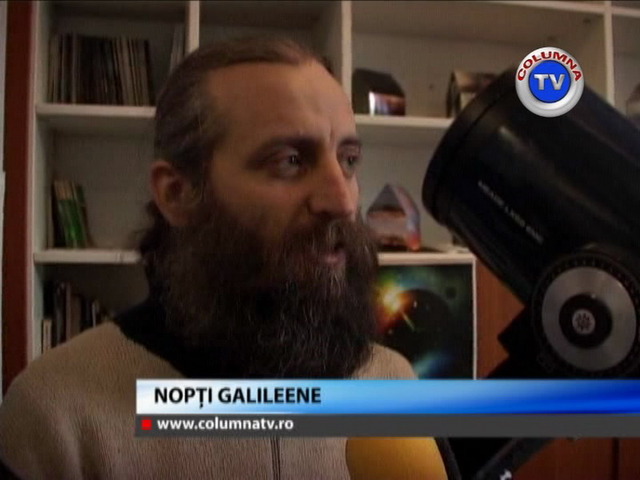
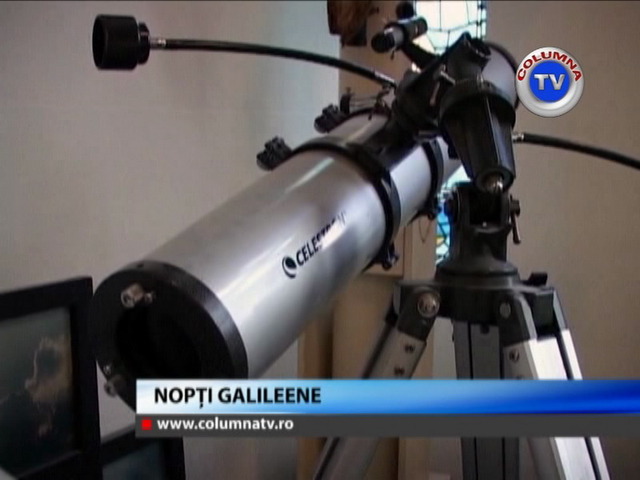
Jurnal de Dambovita (on-line)
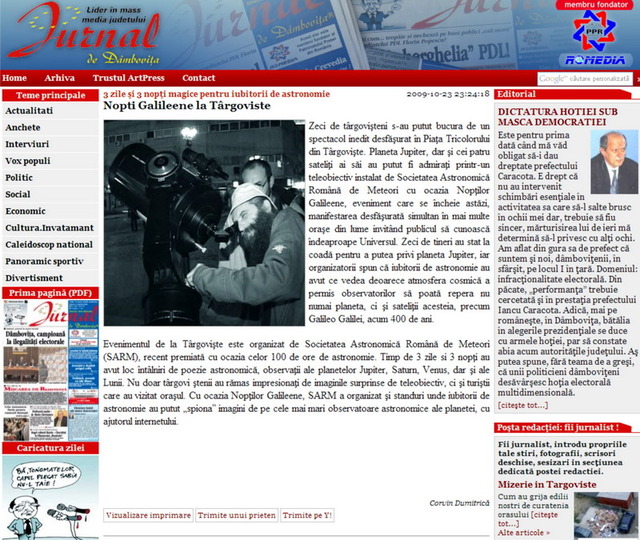
*
HOW IT MOVES
(dedicated to the Great Astronomer)
-by David Kopaska-Merkel (U.S.A.,
Editor of Dreams and Nightmares, the magazine of fantastic poetry)-
Also, and this is important,
not that I am right
(I am),
but this means our world's simply
a gigantic ship
sailing a Grand Circuit every year.
And what if even the mighty Sun,
life-giver,
is itself naught but a coracle on
the sea of God?
What shores might we
set foot upon,
given days enough,
and star-bejeweled nights.
*
GALILEAN NIGHTS - TARGOVISTE:
NOCTURNAL ASTRO-PROJECTIONS IN THE “TRICOLORUL” SQUARE
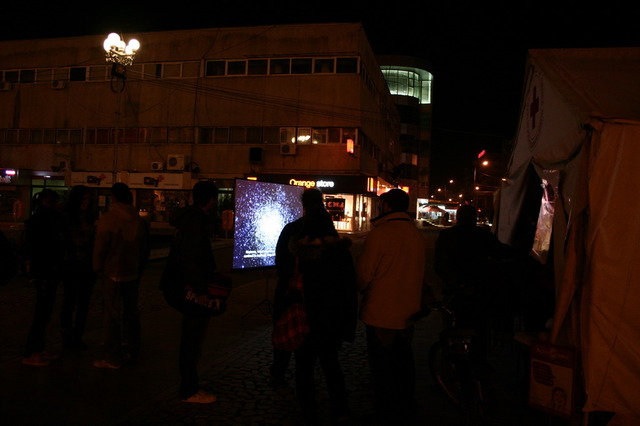
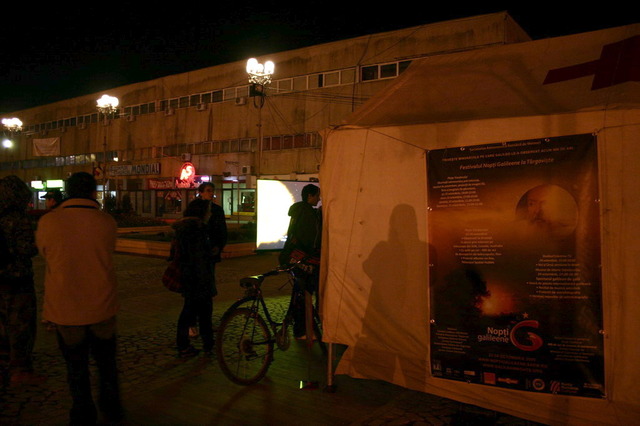
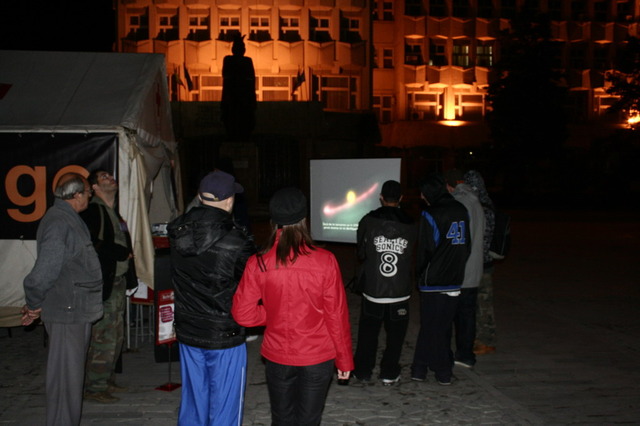
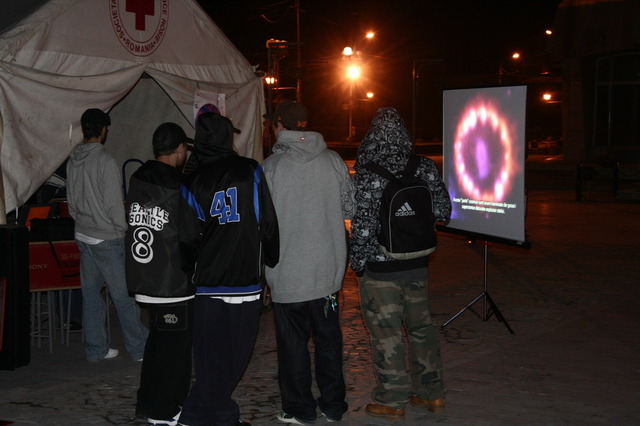
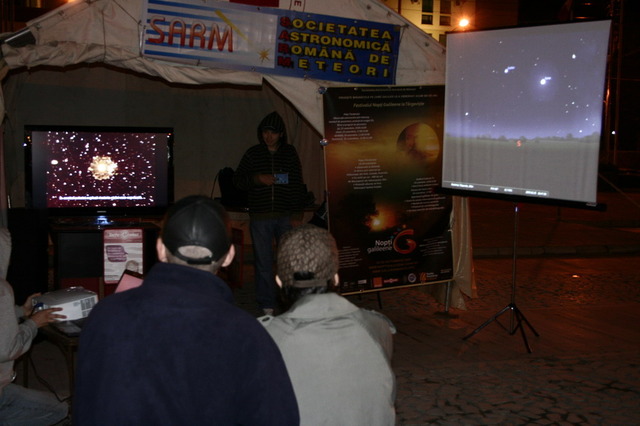
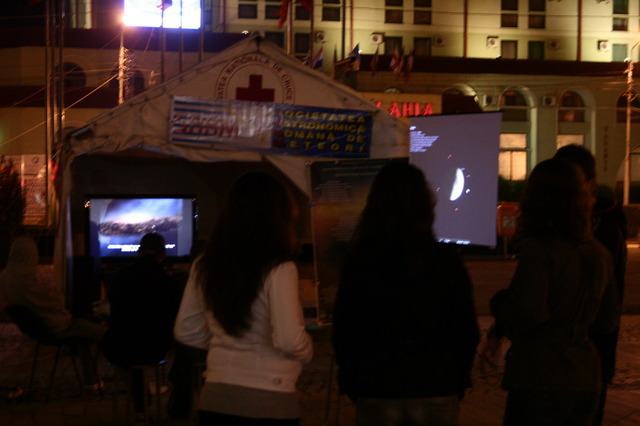
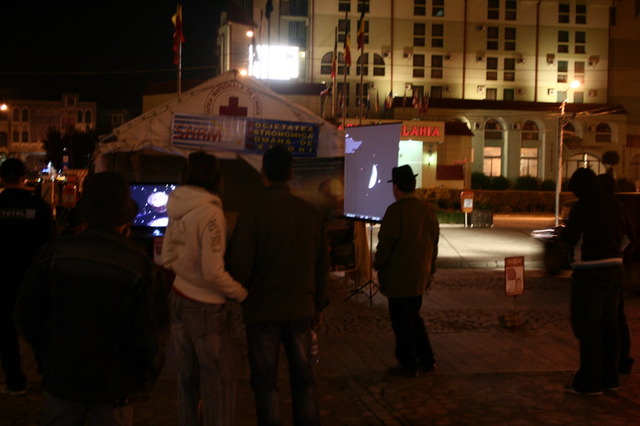
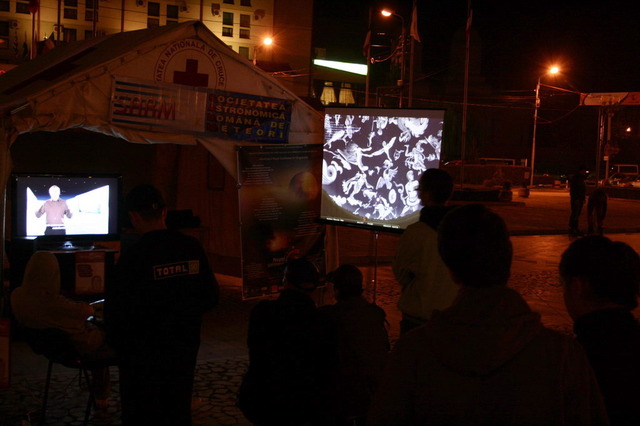
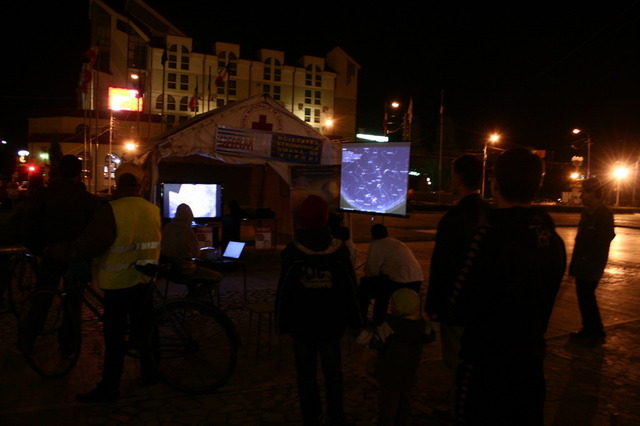
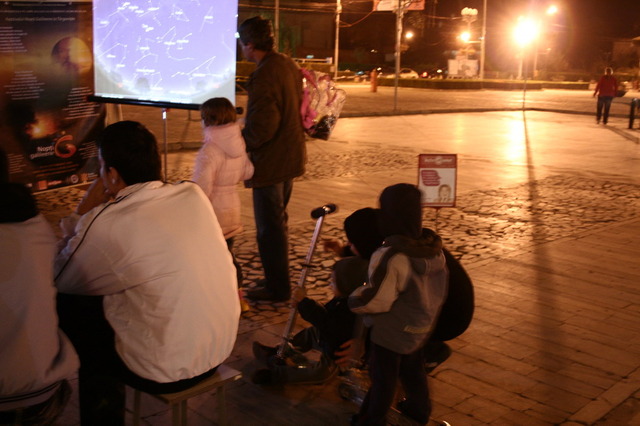
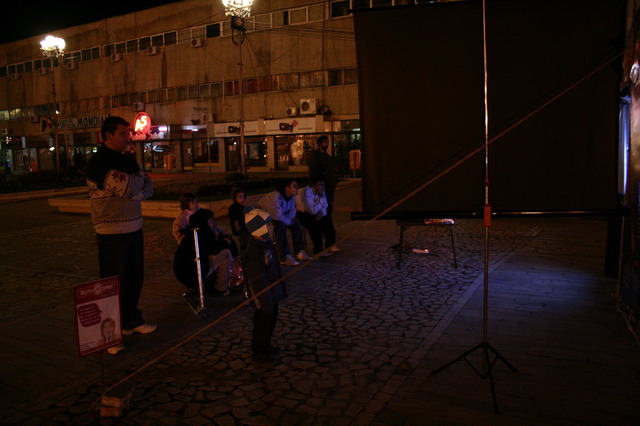
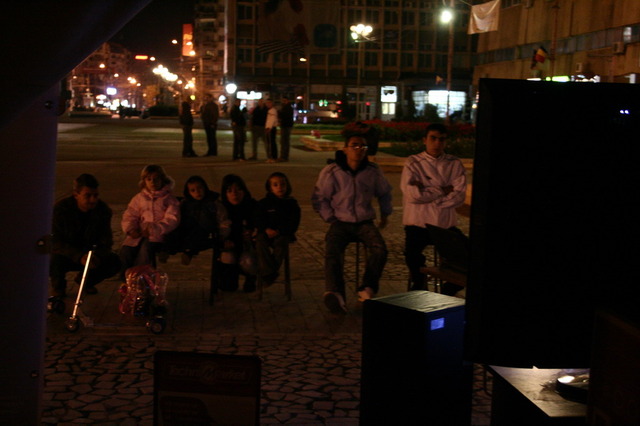
*
GALILEO GALILEI
-by Antoniu Ion Constantinescu-
I don’t know if he was
the greatest astronomer of all times,
but he was certainly he who revolutionized astronomy,
or rather re-invented it,
because without his lunette,
all the heavenly bodies would have remained the same.
“O.K.”, some people say,
“but if Galileo would not have existed,
then another similar genius would have appeared”;
but yet I say that it is important
who the father of modern astronomy
really was.
*
GALILEAN NIGHTS - TARGOVISTE:
THE WONDERFUL TELESCOPE

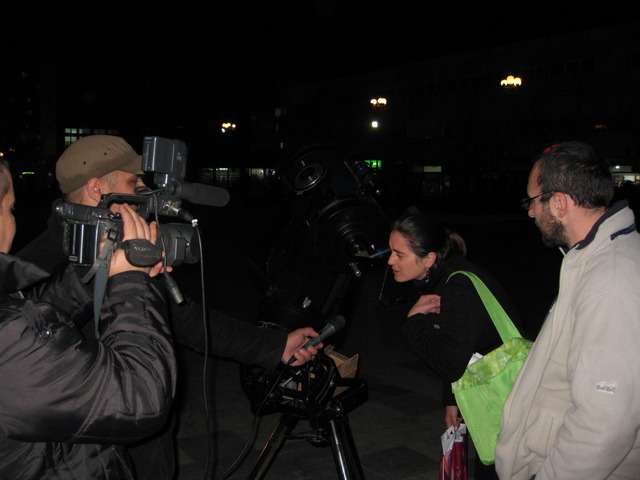
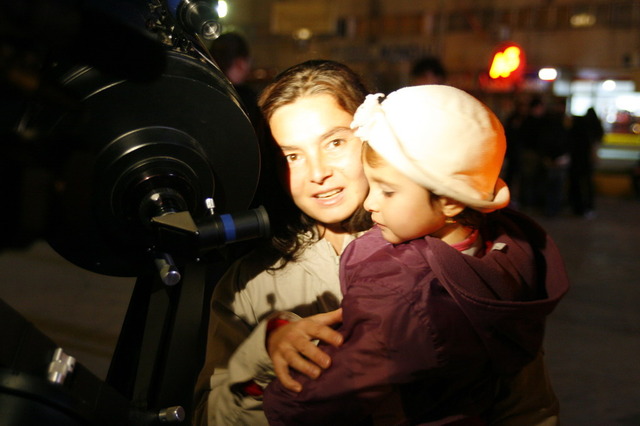
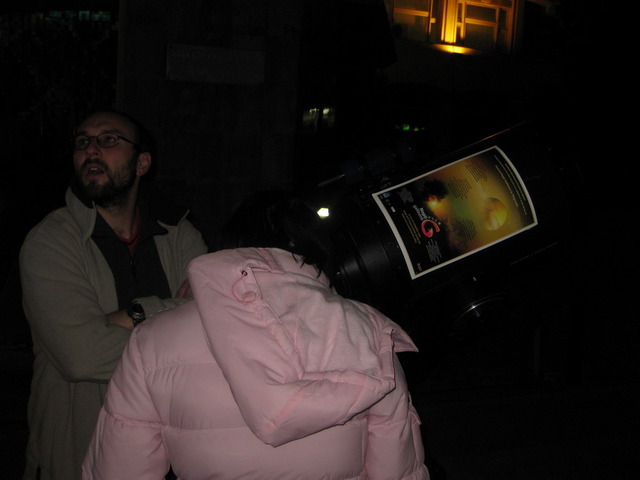
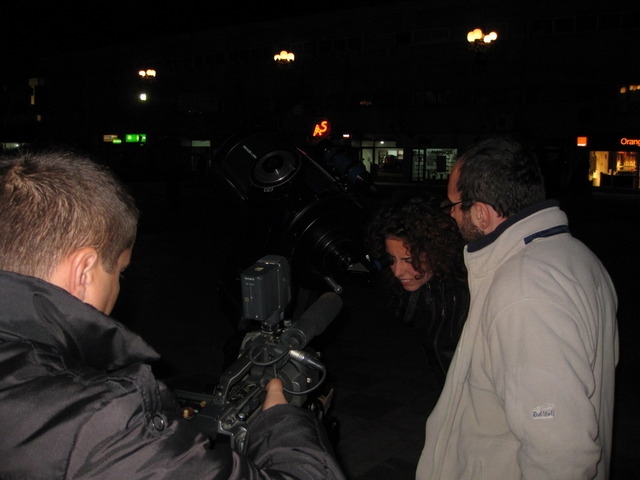
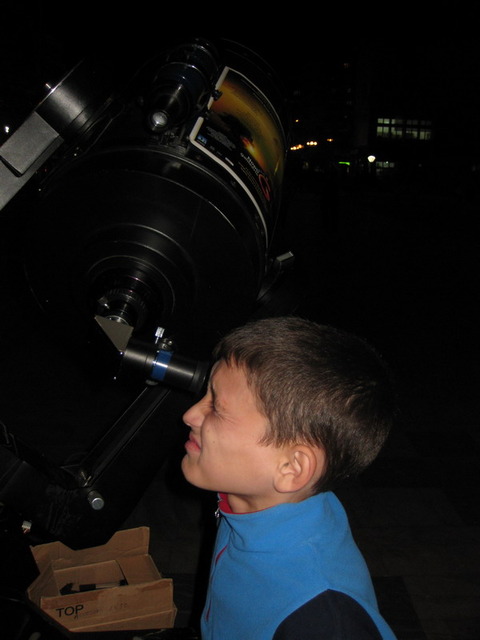
*
GALILEO GAILEI
-by Ion(ut) Moraru-
Galileo watches us
through his lunette,
and we watch him
through the book of history,
while the Sun, the Moon,
planets and constellations
continue to make their job.
*
GALILEAN NIGHTS - TARGOVISTE:
“UNIVERSE AWARENESS” or CHILDREN’S ASTROART EXHIBITION
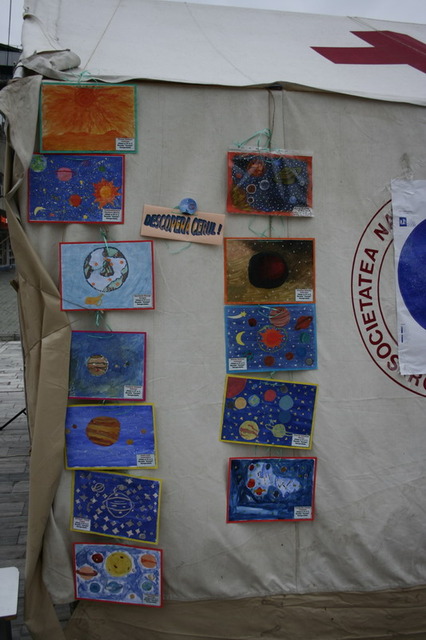
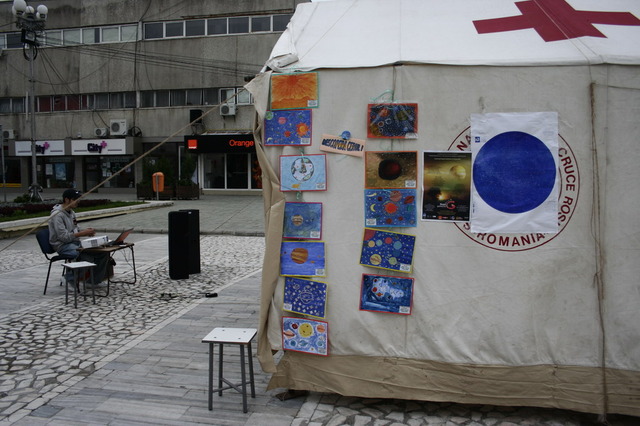
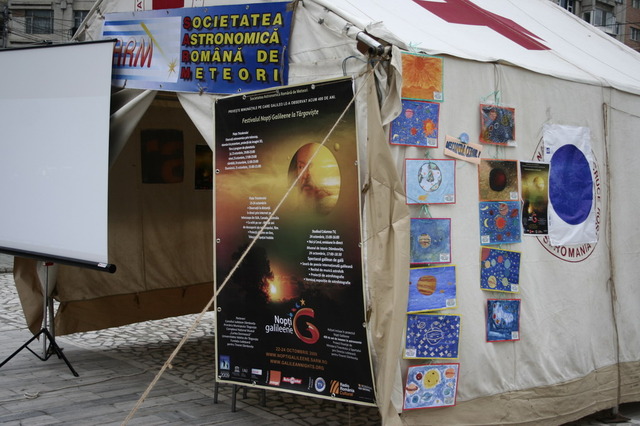
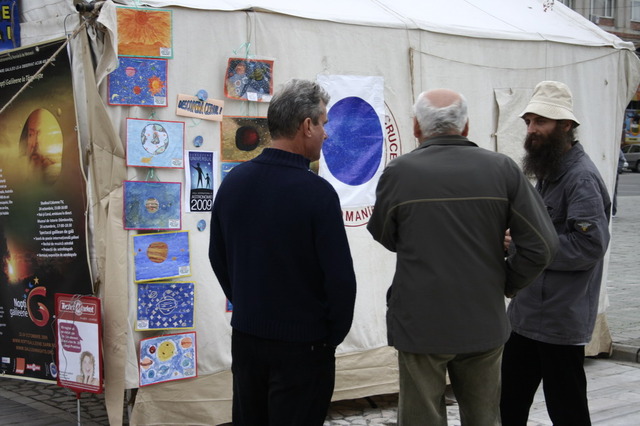
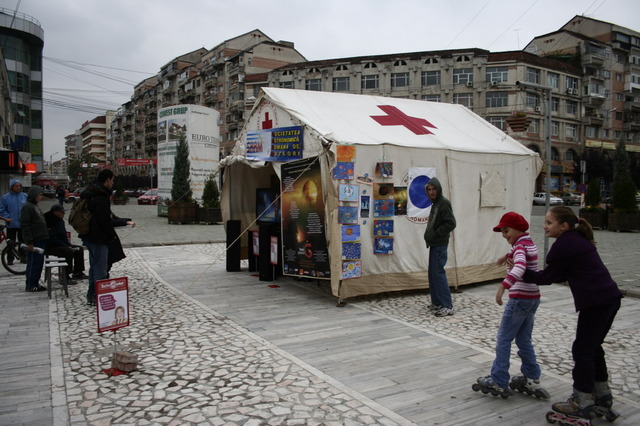
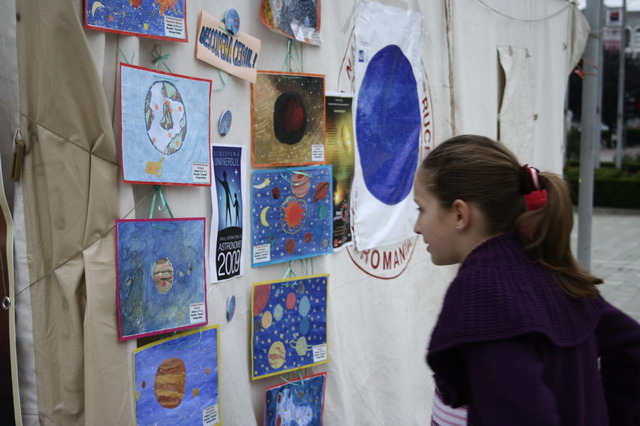
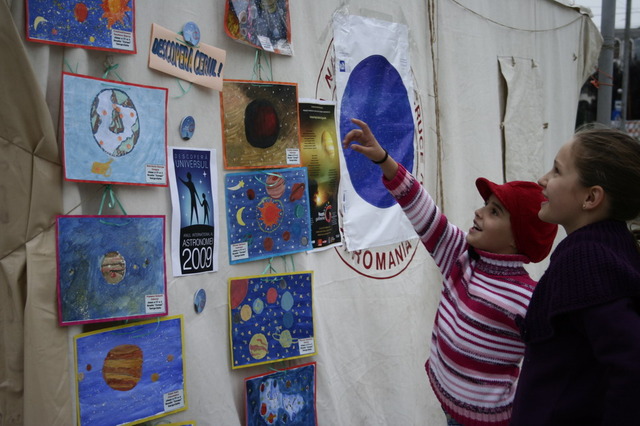
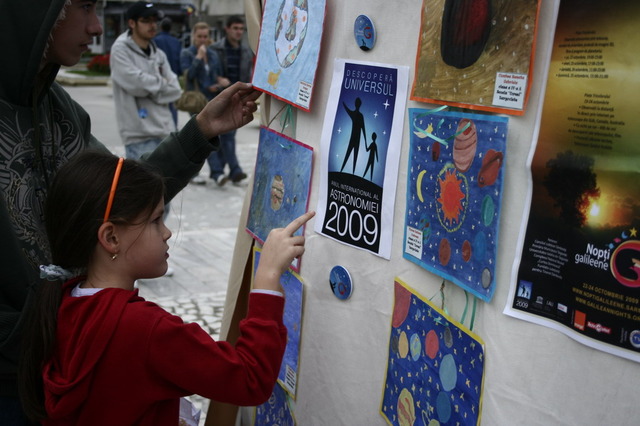
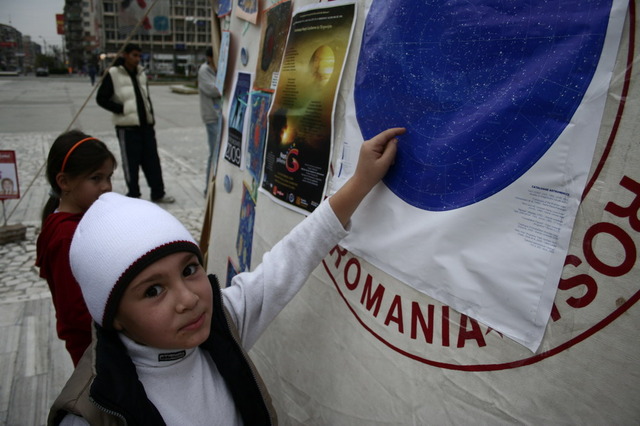
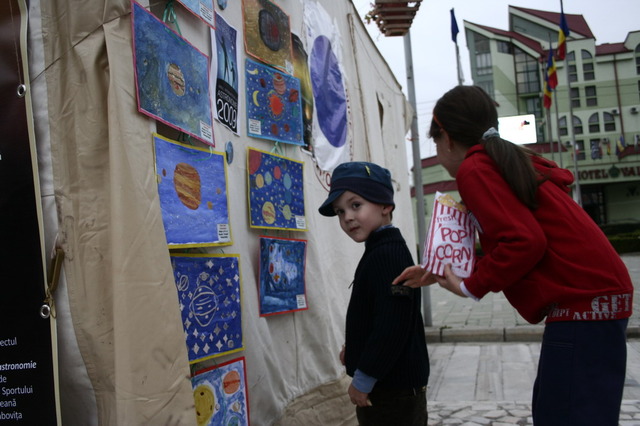
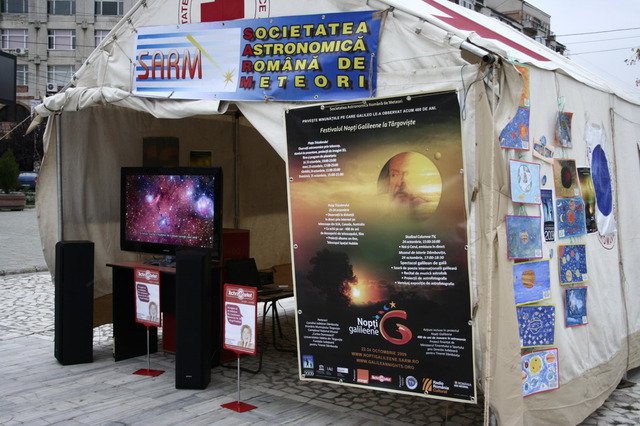
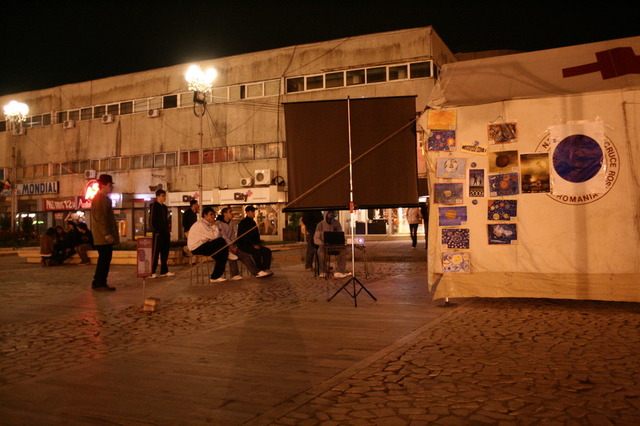
*
THE CONVICTION OF GALILEO
-by Victor Chifelea-
Judges’ speech:
“Culprit,
you are investigated for the intention
to roll illegally the Earth around the Sun.
To persist in such a crime
attracts the punishment
to be transformed into a burning body
in the memory of your sin.”
Galileo’s thought:
“As I am a culprit,
it is my round to convict
the Commission of the Inquisition
to an eternal inert existence
in the bidimensional space
which is carried by the back of the elephants
hosted by the shell of the tortoise
which was created in the beginning of times.
Be always prisoners
of the fear that
sooner or later
the skies will fall
into you!”
*
GALILEAN NIGHTS - TARGOVISTE:
“CORESI” SCHOOL CHILDREN’S ARTWORKS
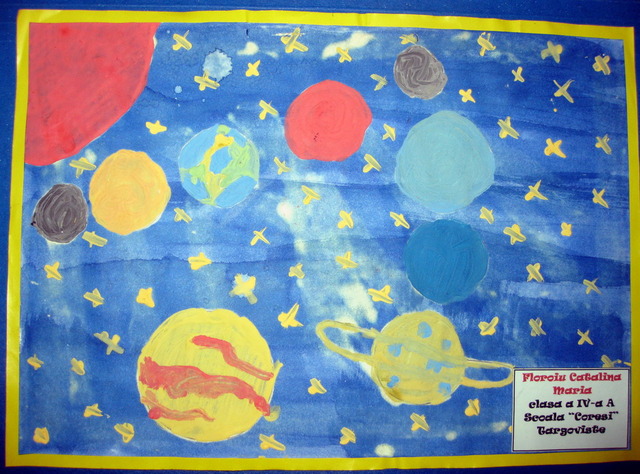
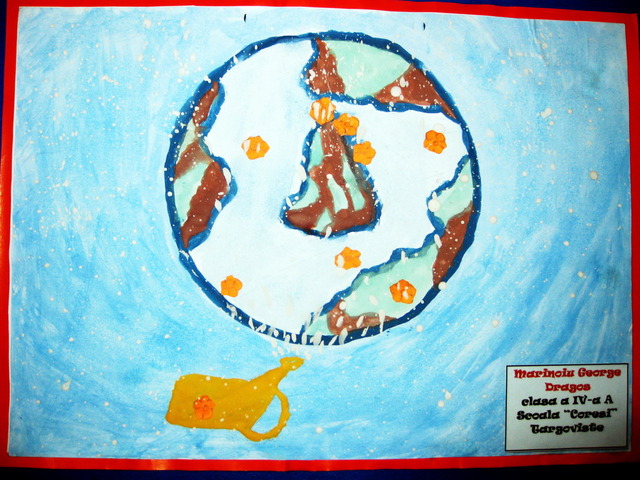
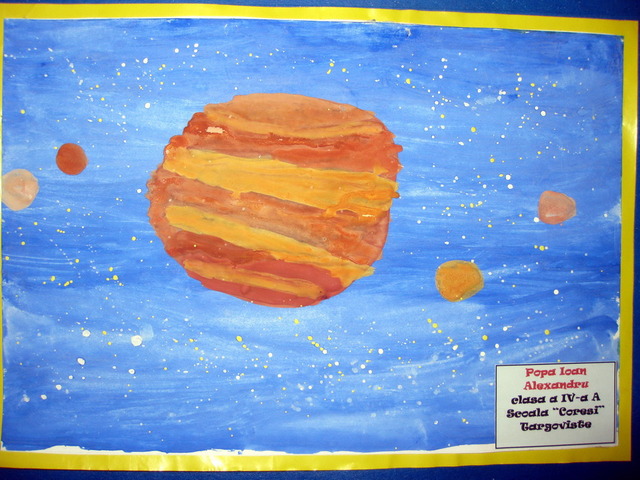
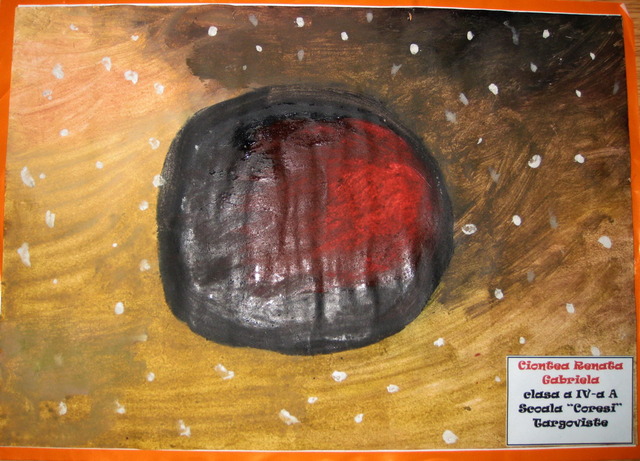
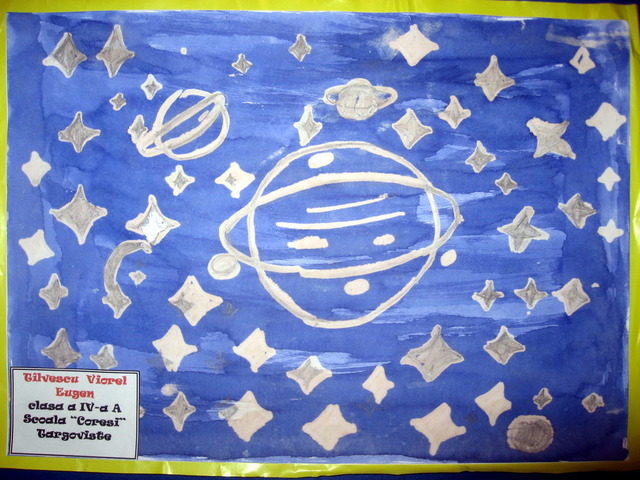
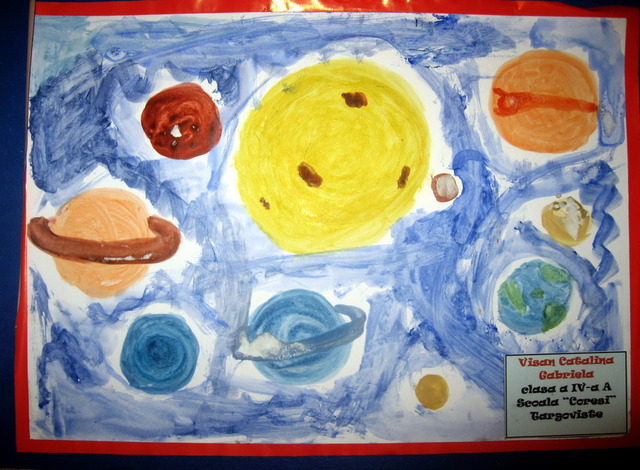
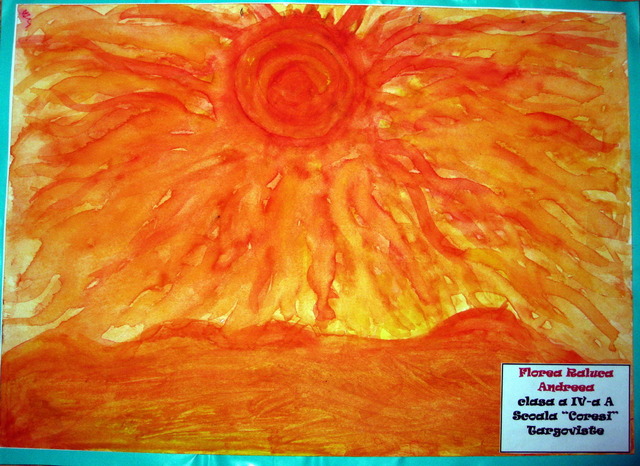
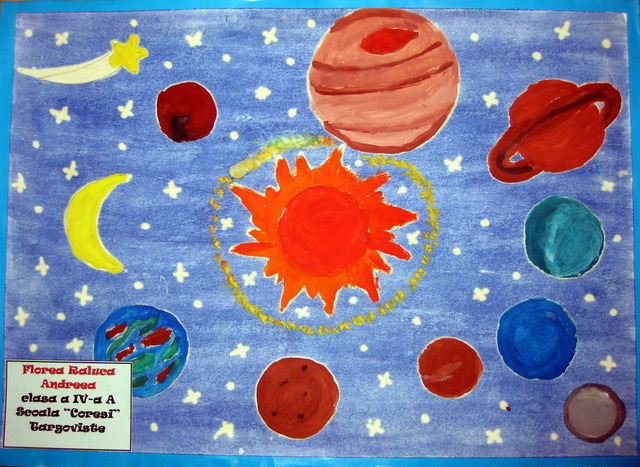
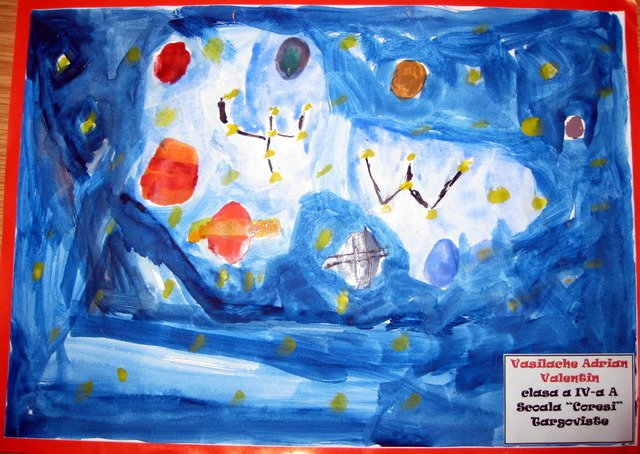
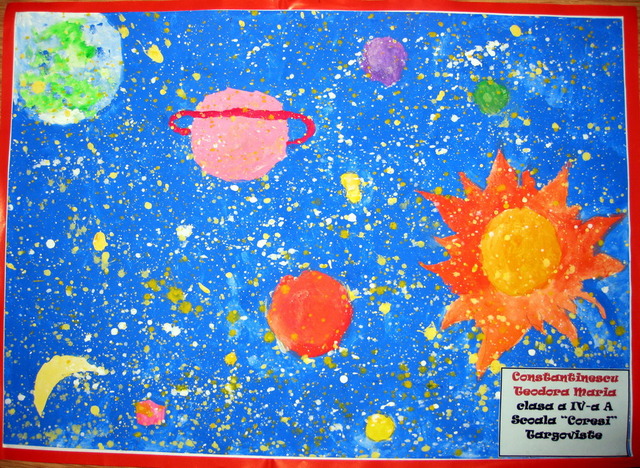
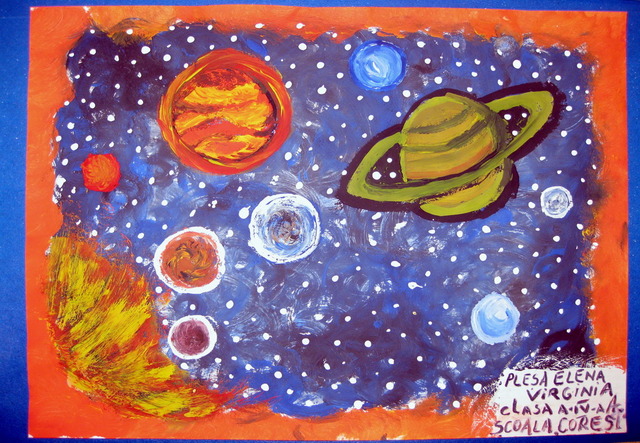
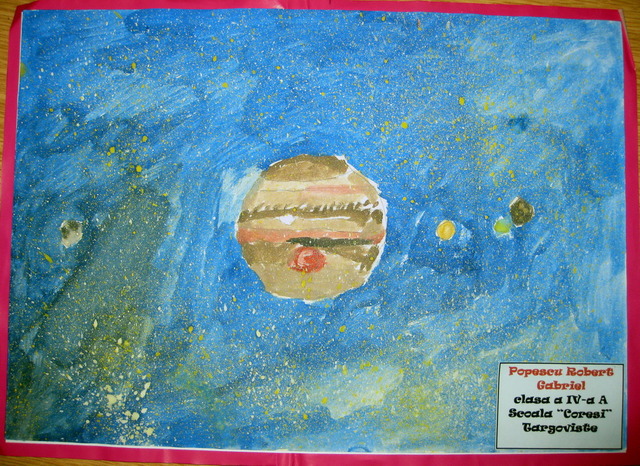
*
GALILEO
-by Dan Mitrut-
Through the beard of Galileo
a lot of sunspots swarm
a multitude of rings of Jupiter
as misunderstood specks of light
Through the eye-brows of Galileo
millions of glass slivers shine
in boreal and austral constellations
lenses broken by question signs
As mysteries know to nest
in the eyes of the prospectors
Galileo carries an enigma
in one of his eyes
and a tear in the other one
If today someone would ask him for an interview
Galileo’s answer would be cheerlessly short:
“E pur si muove!”

*
GALILEAN OBJECTS
-by Adrian Sima-
The great planet Jupiter
is a woman
who still sews space
on her orbit,
kneading the cold
through the light
knitted in the old spy glass
of the centuries.
Engaged 400 years ago
with the proud astronomer
(because that man had seen her fine rings
for the first time),
Jupiter’s sister (the planet Saturn)
looks for the invariable place
of the love declaration.
The Sun renews his spots
that he once showed
to the same curious earthling.
As always,
the Moon says nothing,
like an old stone.
Do you see, Galileo?
The heavenly objects remember you
through us.

*
PRAISE TO GAZE
-by Pompiliu Alexandru-
The shortest road towards the Self passes through the other one.
In order to penetrate deeply into yourself,
you must slope to love.
The way passes through something close,
which is already something far.
Distance and proximity inside our species, on the one side,
distance as a cosmic proximity, on the other side.
When the road towards yourself by passing through the other ones
becomes difficult,
you have to pass through the Universe for the same target. .
Galileo found out the solution to penetrate into himself
by passing through the Universe.
He used artificial pupils, which could penetrate beyond
the destiny imposed to the small and heavy people.
Thus he reversed the way of Oedipus,
who gazed directly into his black, own sky.
Oedipus was a physiologist,
so he used medical means -
he pulled out his eyes in order to scrutinize better
the black sky of the soul.
But Galileo was a traveller through the Cosmos,
so he needed props for tasting
the hidden and rare light of the Universe.
The fire is the proximate light
given by the other people.
Fascinated, we can watch a fire in the night
and feel that it unites us and warms us.
But if this warmth attracts us too much and burns us,
then we run to the other option.
The cold fire of the Universe invited Galileo
to look for the hidden blazes of the suns.
His older brother, Giordano Bruno,
admitted to be sunk in the human fire,
and thus he got to the Self.
More prudent, Galileo chose the cold way
of the Universe watched through the glass.
As clean as a mathematical formula.
And finally he got to the same Self.
The beauty of the way (the domestic fire or the universal fire)
is not important.
Only the action does matter.
How many millions of galaxies are hidden
in the flames of a hearth?
As many as
in the cold fire of the Universe.

*
FROM GALILEO TO GALILEAN NIGHTS
-astro-photo-poem by Valentin Grigore-
Why do we need a lunette?
If the lunette would be invented today,
how many of us would become Galileo?
Why should we watch the sky?
What do we earn?
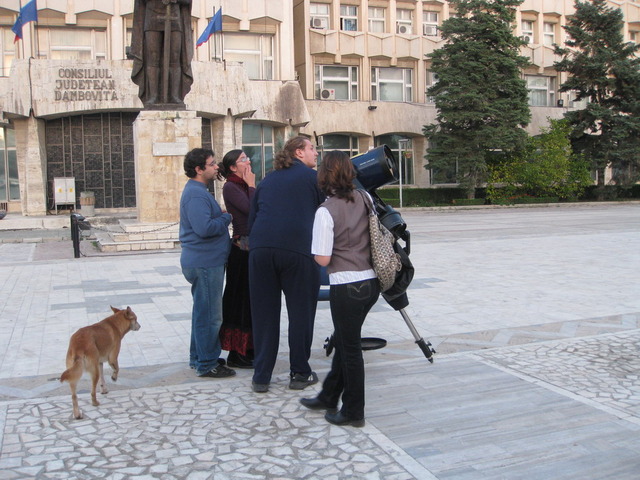
When we watch the sky,
time stops the road of life
towards the end.
Because the sky is even life.
The sky is even eternity.
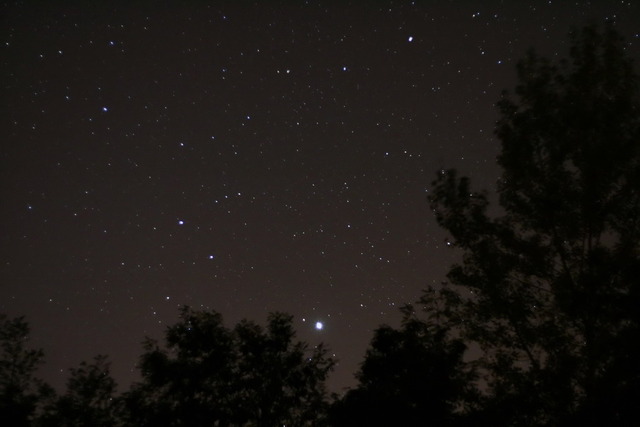
Today, after 400 years,
we are called to return
to the great feeling of
the beginning of the world.
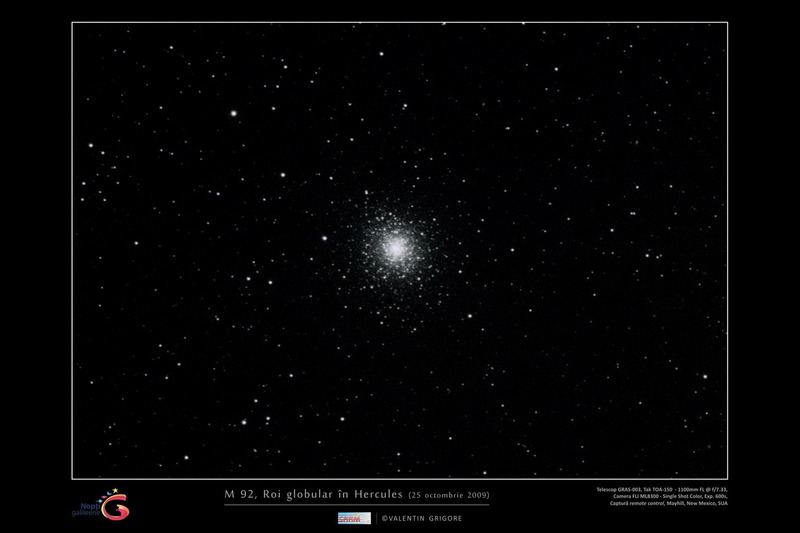
The feeling lived by Galileo
when he watched the wonders of Creation
through a new window.
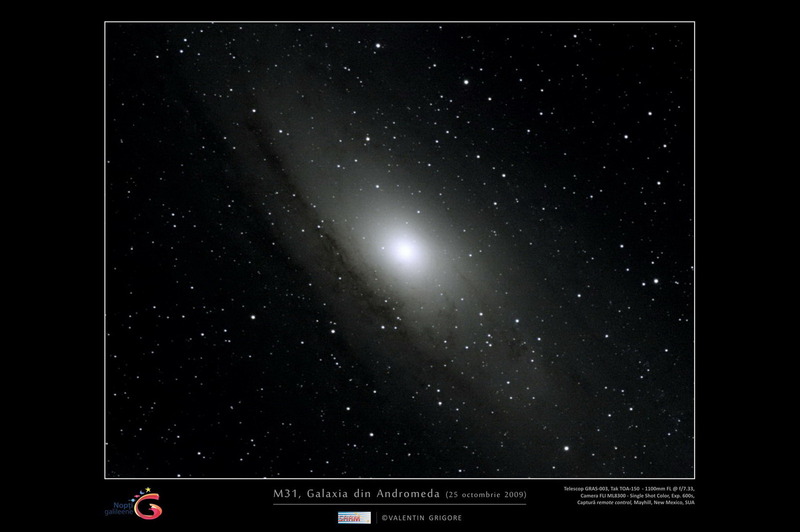
Open that window
and watch beyond
the apparent world.
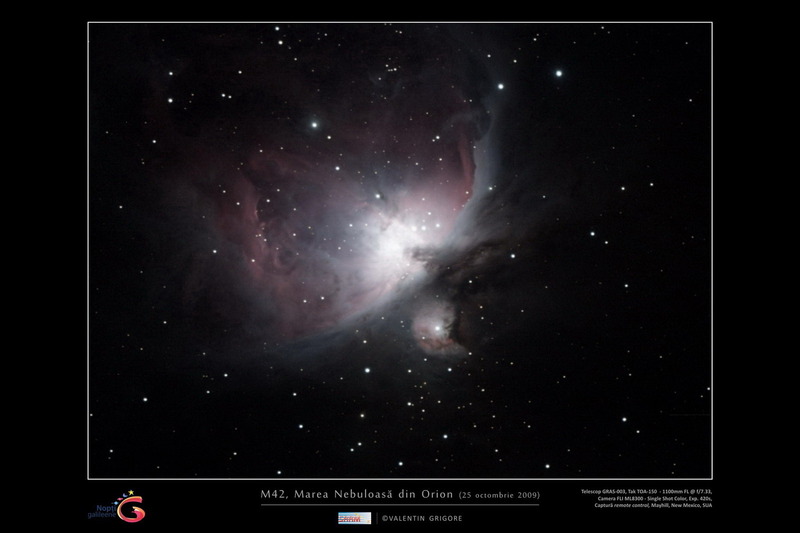
The best lunette
is
the eye of the soul.

Note:
Valentin Grigore’s photos represent:
1. Preparations for Galilean Nights in Targoviste.
2. Jupiter (Priboiu-Targoviste, 2009.10.21-22)
3-5. M92, M31, and M42: remote astronomy - images made from Targoviste (Romania)
by using the telescope of Mayhill Observatory (New Mexico, U.S.A.)
in 2009.10.25, during the programs of Galilean Nights.
*
And finally the last song…

THE LEGEND OF CICORY
-lyrics of an astrofolk drama-song by Dan Mitrut-
Astronomer (shouts):
Wandering, beloved,
left through the sky,
sunflower, tell me how
this girl can go to the Sun.
Astronomer (for himself):
But the way keeps silent,
waters quiver through waves,
and I’m afraid that
no mortal can go to the Sun.
Astronomer (shouts again):
Flower, flower,
what is the road towards the Sun?
Iron boots,
the Pleiades as
a broad-hen with her chickens,
this road is rotated
and blessed by tears.
Flower, flower,
do you know the road towards the Sun?
The destiny is not accomplished…
Girl:
The stars revolve around me
as in a crazy ring dance,
and my unborn son cries.
He is so thirsty, so dizzy…
Astronomer:
Good mother of the Sun,
what is the blame of this life
created from ground and beam?
My powers are at noon.
Be merciful,
she is just a poor mortal…
Voice from the heavens:
Girl, girl,
I shall change your son
into a falling star.
But you have dared
to look at my son,
the great Sun.
It is a sorrowful flesh destiny
to be heavy-hearted by the sky,
but your love is so strong
that I shall change you
into a blue,
blue cicory flower.
Astronomer:
What is the road towards the Sun?
Cicory, cicory,
just tell me…

*
“GALILEO GALILEI”
AND THE SARM ASTROPOETRY DREAM TEAM



*
Note:
These poems were read at the Galilean Gala Show in the Romanian language.
The photographs of this web page were made by Valentin Grigore (most of them),
Ciprian Grigorescu, Dan Mitrut, Pavel Tica Popescu, Adrian Sima,
Cristina Ungureanu, Alexandru Sebastian Grigore and Cristian Daniel Grigore.
Other important roles in organizing Galilean Nights in Targoviste had
Florin Stancu, Catalin Stan, Adrian Apostol, Andrei Matache,
Andreea Gluch, Madalina Stancu and Mariana Grigore.
*
STELIANA GHEORGHE TROPHY
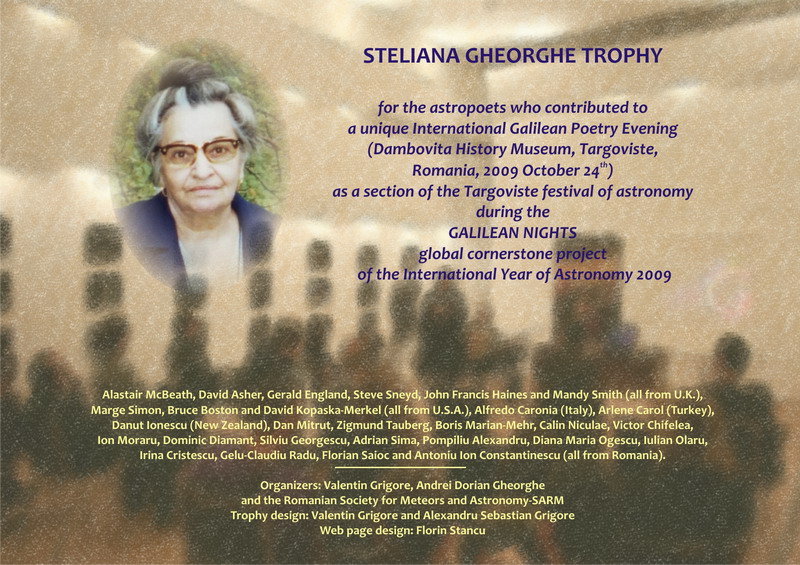
*
POST SCRIPTUM
A few months later,
in March 2010,
the international team that had created the extraordinary
global cornerstone project
of the International Year of Astronomy 2009,
Galilean Nights,
announced the Award Winners
in the IYA2009 official web site.
And there,
“Galilean Nights Festival at Targoviste
run by SARM - The Romanian Society for Meteors and Astronomy”
was declared
(receiving also “congratulations”
from Pedro Russo - Portugal, IYA2009 Coordinator -
and Catherine Moloney - U.K., Galilean Nights Chair)
WINNER
for
OUTSTANDING GALILEAN NIGHTS EVENT.

*
HOME NEXT